#heavily inspired by spooky/horror tropes
Explore tagged Tumblr posts
Note
More of a meta question, almost (if not all) of your writing has been when monsters have made their way to surface. Would descendtale follow this still or would stories with them follow a reader insert that fell underground with them?
I like the idea of it being open to either!
'Fell into the Underground' stories can be a lot of fun so I kind of like that this one has more built-in space for that, but in terms of getting the Descendtale monsters up to the surface...
The Frisk of this 'verse/timeline has no interest in or thoughts of going back to the Underground.
However, they have just found out that magic is real, and that they can do it. They live the rest of their life as a mage, doing real magic and showing others how to do it too.
Most people hearing about what they can do--and what people who learned from them can do--dismiss it easily enough. Sleight of hand, special effects, digital editing, people have been faking 'magic' about as long as the word's existed, this latest brand of it is just another fad, a hoax.
Still, it becomes something of a subculture, mixing in with similar trends like witchcraft and the occult in general.
Decades later, most people who get into that sort of magic can't do anything too impressive, but it's especially popular in Ebott, a place with lots of local legends about the mountain, monsters sealed away beneath it, people going missing around it--really spooky, mystical stuff...
It's the perfect place for a group of young aspiring mages to go to attempt the weird ritual they found in a creepy old book they found in the back of the occult section of the local library.
And well...young people with old magic books containing incantations they don't fully understand will do what young people with old magic books containing incantations they don't fully understand do and, between them all, the Barrier is broken.
Eventually, monsters start to trickle out and the rest is history...or rather, the present.
#anonymous#descendtale#headcanons#heavily inspired by spooky/horror tropes#so of course i have to integrate the 'teenagers accidentally do a real spell and shit goes down' trope#except the terrifying monsters they've unleashed upon humanity are mostly pretty chill
29 notes
·
View notes
Note
hi!!! i absolutely adore reassassination and im not sure if this has been asked yet or not but how did you come up with the plot/general idea of reassassination?
ah the inspiration for RAA came from a lot of things! some media and some personal experiences.
the style of RAA is heavily inspired by late 90s to mid 2000s cartoons and subcultures like goth, industrial/rivethead culture, scene, and spooky kids/nu metal/mall-goths. originally each character was to reflect a certain subculture and this still exists loosely within the series (eg. valentine/angel is based off of gyaruo, and onion is intended to be slightly reminiscent of emo). and of course, horror films, especially campy ones. stuff like rocky horror, saw, ginger snaps, and the machine girl!
i came up with the plot by chance. before finalising the premise of "zombie girl comes back from the dead to get revenge on her killer", i rewatched all of panty and stocking, and really loved the idea of a badass killer girl and her strange mysterious mentor. it's my fav trope, esp in stylish movies like sucker punch. before that, i had a very loose premise of octavia and kranken running a fucked up clinic together in episodic fashion - think like "clinic of horrors" by merryweathery.
anyway we eventually got to the premise of "zombie girl attends school killing people in secret to advance her mentor's plans". i needed to flesh things out a bit, so added some villains (then a school council rather than a full org), and gave octavia a simple, edgy little motive - kill her killer. i thought it was funny and fitted the "edgy on purpose" vibe i've always wanted RAA to have. the plan for the format changed from mostly vulgar, episodic comedy to slightly more serious serialised horror dramady, but the edgy, silly premise remained.
if you wouldn't mind me talking about it in particular, parts of the clear crucifix org are inspired by televangelism and the churches my mother would take me to when i was younger for the most part. televangelists are self-righteous, holier-than-thou scumbags who pressure the vulnerable into giving them money and relying on them out of the promise of salvation. the fact that they take christianity and warp/ignore/change the rules around to fit their plans inspired the philosophy of the CCO - it's exaggerated in that they blatantly go against their own religion by basing their org off of killing those they see as unrighteous or wrong. i went to lots of different churches when i was younger - some more protestant and some more pentecostal, though CCO ended up being based on catholicism because i know a lot about it (got a 8, the UK equivalent to an A, in religious studies lol). to me the protestant churches seemed a lot lighthearted but still had that underlying sense of judgement and shame, and the pentecostal churches were pretty explicitly "if you don't believe/if you are gay, trans, or anything against the norm you will go to hell". those pentecostal churches were also more violent and scary to me as a kid (exorcisms and religious ecstasy creep me out to this day) which inspired the more intense, horrific torture-esque parts of the CCO that will be in the comic!
well i hope you don't mind that wall of text lol, i could write more about specifics but i don't want to go into too much detail about everything! thank you so much for this question! :D
24 notes
·
View notes
Text
i finally watched the backrooms webseries by kane pixels!
because "weird architecture"-based horror is one of my absolute favorite vibes, i knew i had to check it out eventually. and i'm glad i did! overall it's astonishingly well-done, especially from a technical/effects perspective. very good visual design, audio design, etc.
under the cut i'll add some more detailed thoughts + criticisms!
things i liked:
pretty much all the found-footage episodes are extremely well done. there's real tension! it's super spooky! my favorites are the ones entitled "pitfalls" and "found footage #2." i really enjoy how the creator is able to innovate on the concept of the backrooms, keeping things visually cohesive while branching out into various styles of architecture. i don't think i can do them justice other than to say that the vibes are perfect.
i also found myself more invested in the main "plot" of the series than i thought i would be. i like the interactions between the scientists/explorers; they're both fun and also realistic-feeling. while the introduction of async (the shady corporation trying to expand into the backrooms) initially made me go "what a cliche!" - i think their goal of ~solving the housing crisis~ by building shitty homes in a dangerous alternate dimension is pretty unique and interesting. i love the parts where it's clear they're rushing the job of making the backrooms "habitable" because they want to impress investors. it's not what i expected from the series, but i'd love to see more of that. always gotta respect a horror series with concrete themes.
also, this is very specific, but i like how the explorers have lots of lingo and safety procedures. that's an important part of making something like this actually feel naturalistic. i am convinced that this is a real, government-funded investigation!
neutral observations:
while i don't think it's fair to call the backrooms webseries cliche/unoriginal, it's clearly building heavily off of preexisting media. kane pixels's youtube channel makes it clear he's a portal fan - that's absolutely an inspiration here. there are also heavy vibes of control (2019 game) and annihilation (2018 movie). since all of these are things i like, i'm happy! and i think the webseries is doing a unique spin on "shady government project sends scientists/explorers/etc into surreal alien phenomenon." but at the same time, i find myself questioning why it always has to be a shady government/corporate project. for sure, it lets you investigate themes like "the limit of science" and "how much control do these organizations have over us and do they really care about our safety" and fun things like that, but i would have been equally happy if it wasn't doing that trope again.
i also have no strong opinions on the idea of introducing monsters into the backrooms. some people have strong opinions on this. i think the monsters add to the tension in fun ways. i like how inhumanly they move! and i like how it's implied (ish? at least this is my theory) that the monsters are mutated forms of people who've gotten lost in the backrooms. and how they have this kind of fungusy vibe...
for the most part, though, the series is scariest when there aren't any monsters around. but the threat of monsters keeps tension high, and i like how they're integrated into the plot so far. it's less about monsters being present and more what you do with them, i think?
criticisms:
my biggest criticism might seem like kind of an unfair one, but it's central to how i view found footage as a medium/genre. fundamentally, to me, found footage is about medium-as-plot-device - the camera is a character, the editing is done by people in-universe, and there should be a strong feeling that the work is presented the way it is for a diegetic reason (even if we don't know what that reason is).
the backrooms webseries consistently fails to convince me that it is entirely shot and edited in-universe. one might say "but it isn't trying to be convincing in this way," but i don't think that's true - the way the episodes are labeled with dates, and the way everything is cut together, makes it seem like it's presenting curated videos from the fictional 90s. it's possible other people are more lenient about "what a found footage series should be," or if they classify backrooms as "found footage" at all! but the way i read it, its particular priorities as a found footage series seriously clash with my own definition of what a found footage series should be concerned with.
i find it particularly jarring when it's playing spooky music over cut-together photos and video. even if async is supposed to be sinister, why would they make videos that so obviously paint them that way? is somebody else supposed to have created some of these videos? if so, i would have liked an indication of who and maybe why, even if it isn't really explained! the final episode (for now) does this pretty well - presents itself as an internal communication to be shown to other async employees. the episode "motion detected" is also really good: it's clear what purpose the video has in-universe. but others, especially towards the beginning of the series, feel jarring because their creation isn't so grounded in the universe.
there are also segments where the filmmaking language shifts from found footage to cinema. see, i think i understand why these segments are here, but i simply do not think it works at all. when you create found footage, you, by nature of the medium, make your viewer extremely aware of the camera as an object. when the series shifts into a cinematographic mode - filming and cutting between actors like in a movie - it feels incredibly fake. (see the episode "report" for an example of this.) who is filming these people? why? why cut stuff together in this way? i get the sense that it's supposed to be an "objective" view of stuff going on outside the backrooms, stuff that no in-universe cameras are supposed to see, but if that's the case, the series's chosen medium has already undermined any sense of objectivity here, since previous episodes have taught us to question the camera. i do hope any continuation to the story addresses this! i would love to know why async is filming themselves like this! and it's always possible that the cinematic language is supposed to make the viewer feel uneasy. but idk. i'm not a fan
overall, the backrooms is truly excellent found footage horror. when it stops being found footage, though, the found-footage-ness of the rest of it can't help but make me stop suspending my disbelief!
5 notes
·
View notes
Note
Ooo can u rec a few of ur fav horror books love love love spooky reads :)
🤩oh man here we go let me open the book. a bunch of them under the cut!
Haunted House Classic - The Haunting of Hill House by Shirley Jackson Not the first haunted house story by any means, but a lot of modern haunted house stories draw from this one specifically. A wealthy old man invites a group of people to investigate his house to find concrete proof of the supernatural, only for things to go awry as they realize the house is haunted. Gets really mind-trippy towards the end. Modern - The Hacienda by Isabel Cañas Our protagonist marries a rich man to escape a life of poverty and gain some stability in the aftermath of the overthrow of the Mexican government. As she stays at the hacienda, however, it becomes very clear that something is haunting and watching her every move -- as the staff vehemently deny anything happened to the master of the house's first wife, the protagonist turns to an unorthodox priest for help.
Humor
Grady Hendrix is probably the biggest name in horror-comedy right now, and I'm really enjoying his stuff! My favorite so far of his is How to Sell A Haunted House: in the aftermath of her parents' sudden death, a young woman returns home with her burnout brother to try and figure out what to do with her parents' sizable (and possibly haunted) puppet collection. Really tugs at the heartstrings with the plot being utterly off the wall. Also enjoyed Southern Book Club Guide's to Slaying Vampires by him, about a small southern town that realizes they have a vampire in their midst!
Shlocky
I always have to recommend Riley Sager's books because they feel like reading a B-list horror film: they can be silly, they can be a little shallow, they can be full of unnecessary twists, but they're also a lot of fun and feel like they run with a lot of horror tropes. Home Before Dark is his best-known: growing up, the protagonist's parents exploited the so-called spookiness of their family home (very much a la Amityville Horror). As an adult, she returns to her childhood home and realizes it might not all have been fake.
Sci-Fi Horror
The Annihilation series by Jeff VanDerMeer is really good: a group of scientists given only by their title (the biologist, etc) explore this strange new territory filled with secrets and suspicious creatures, only to realize they may have a traitor in their midst. The first of this series is my favorite, and the dream-like narration might not be for everyone, but the imagery is stunning (and if you do read and like it, audio drama Syntax is heavily inspired by it!)
The Last Astronaut by David Wellington: My god, an asteroid is about to hit Earth (very, very slowly!). To investigate what it's about and how to stop it, a former astronaut and their team go to explore it... only to realize there's more secrets than they realize lying inside, and that it may not be an asteroid after all. Really spooky, ending made me emotional.
Fake Oral Histories (Oral Histories are some of my favorite subgenres of books in general! Basically like World War Z - not written in explicit prose format, but taking advantage of other ways of displaying the story - newspaper articles, interview transcripts, court hearings, etc!)
Devolution: A Firsthand Account of the Rainier Sasquatch Massacre by Max Brooks - Speaking of, the guy who wrote World War Z! A town is found massacred, seemingly by the mythic Bigfoot. Journals and various other articles are found around town that explain the weeks leading up to the final slaughter. Really tense, had a lot of fun.
A History of Fear by Luke Dumas - Grayson Hale, AKA the Devil's Advocate Killer, was sentenced for the murder of his fellow graduate student. His account of what happened is found in his jail cell following his death, where he describes how he was approached by a man who he believes to be the actual devil. The framing device for the book is an editor trying to explore more about the Hale case, and it is really fun seeing the editor's version of the story (interviewing people in the Hale statement, seeing conflicting newspaper articles, etc) and how it compares with Hale's. I do have to give a massive religious trauma/homophobia CW on this one though.
Fantasticland by Mike Bockoven - I have commitment issues about calling any singular book my favorite, but Fantasticland holds a special place in my heart. In short: a series of interviews from a bunch of Disneyland-esque theme park workers, mostly teenagers, about an incident in the park. A hurricane forced everyone to evacuate but the employees, who hid in underground bunkers. Soon they emerge to see the damage, but in the several weeks it takes for the flooding to clear, all social order breaks down and gangs start to form: the Pirates, the ShopGirls, the Freaks, the Mole People, all based on different areas of the park. I just think it's really cleverly done and a lot of fun (and also, you know, a little horrifying).
#a small book of recommendations but alas#every time i find another oral history book i devour it like a mongoose#such a fun genre#and yes! my god i read a lot of horror and there's so many different subgenres and so much going on rn
16 notes
·
View notes
Text
Horrors on Screen: Evolution of Horror Movies for Halloween

As the leaves turn golden and the nights become longer, the anticipation for Halloween grows palpable. People begin hunting for the perfect Halloween costumes, and stores start to showcase spooky decorations, and horror movies dominate your screens. It's a time for thrills, chills, and cinematic spooks. But have you ever stopped to ponder how horror movies, an integral part of the Halloween experience, have evolved over the years? 1. Silent Era Nightmares: Where It All Began Horror movies began in the silent era before the screams, jumps, and eerie background scores. The use of shadows, exaggerated makeup, and subtle gestures captured the audience's attention. Movies like "Nosferatu" (1922) utilized dark imagery and gothic settings to create an atmosphere of unease. Without words, these films relied heavily on visual storytelling. Can you picture sitting in a dimly lit theater, with only the flickering images and live piano music setting the tone? 2. Technicolor Terror: The Birth of Vibrant Horrors With the advent of sound and color, horror movies underwent a dramatic transformation. Suddenly, the monsters could speak, and the dark black-and-white world was replaced with vibrant colors. Films of the '50s and '60s, such as "The Birds" and "Psycho," highlighted the shift from supernatural beings to more human-centric threats. The audience started to see monsters in ordinary people, making the horror more relatable and, in a way, more frightening. Just as children parade in colorful Halloween outfits, horror films started displaying a richer palette, only with a more sinister undertone. 3. Slasher Surge: The Age of the Anti-Hero Come the '70s and '80s, a new breed of horror was born – the slasher film. Icons like Freddy Krueger and Michael Myers became household names. These characters weren't just faceless monsters; they had backstories, motives, and distinct personalities. It's fascinating how these villains, while terrifying, garnered a fan base of their own. Was it the allure of the forbidden, or did the audience see a twisted reflection of society's dark side in them? 4. Psychological Horrors: Delving Deeper into the Mind The late '90s and the 2000s marked a notable shift towards psychological horror. Gone were the days of visible monsters and gore. Now, the true horror lay in the unseen, the unsaid. Movies like "The Sixth Sense" and "The Others" played mind games with the viewers, making them question reality. This era celebrated the fear of the unknown. It proved that sometimes, what's left to the imagination can be far more terrifying than what's shown on screen. Smiffys states, “Choose from a huge range of Halloween fancy dress costumes with freaky full outfits based around a variety of themes, such as scary doll costumes, to quick and easy kits for the time-conscious and some frightening final touches available from our awesome collection of Halloween accessories.” 5. Modern Horrors: A Blend of the Old and New Today, horror movies have become a cocktail of the past and present. There's an appreciation for classic horror tropes, but filmmakers are not shy about experimenting. From found footage films like "Paranormal Activity" to socially conscious thrillers like "Get Out," the genre is constantly reinventing itself. And just as today's Halloween outfits draw inspiration from various eras and cultures, modern horror is a mosaic of influences. Horror movies, much like Halloween itself, have experienced an exciting evolution. The journey has been spellbinding, from silent films that sent shivers down the spine with mere shadows to thought-provoking modern-day thrillers that explore societal issues. As we dress up in our Halloween dresses and prepare for a night of trick-or-treating, let's also appreciate the rich tapestry of horror movies that have contributed to the spirit of this holiday. After all, what's Halloween without a good scare? Read the full article
1 note
·
View note
Text
a list of horror tropes and themes in chapter 2 of deltarune
as noted by an amateur spooky movie watcher. spoilers undercut
to start off, Spamton’s design instantly reminded me of two characters from classic horror movies. Billy from Jigsaw (whom Spambot heavily resembles) and literally every horror movie to feature a ventriloquist doll. Spamton’s bulging big round eyes, rosy cheeks, and slot machine like mouth instantly gives off “horror puppet” vibes. I’d be surprised if Toby DIDN’T take inspiration from Billy/Jigsaw for his design.
the “mysterious and potentially dangerous stranger on the phone” is an old horror trope you don't see so often anymore because we all have caller id and voice mail these days and you can block shady people, but way back when you didn’t know who was calling you until you answered. (and i mean i still get heart palpitations whenever someone calls ME SO) Gaster’s connection with the phone; you hear his voice when you try to use the phone in chapter 2, the wrong number event in undertale, and the fact that Gaster’s voice sounds like a dial up tone when bundled together is definitely a call back to this trope
speaking of Gaster: Gaster is literally your classic “haunted video game” cryptid. enough people have analyzed this to death already so i’ll only give it a passing mention here.
Snowgrave/Pepis Route is the most “video game creepy pasta” thing i’ve seen in years
being driven insane by forbidden knowledge (read: Jevil, Spamton) is classic Lovecraftian horror trope
the fear of the unknown, specially regarding a powerful force you can neither see or nor control is another that feels lovecraftian. throughout the first and second chapter of deltarune you get the sense that something is wrong but you don’t know what or who is behind it. toby continues to tell us no matter what we do the story will have “one ending” the story will always end the same way. that in-of-itself is another kind of horror. in a way, we’re kind of getting a taste of what Sans experienced in undertale. karma much?
possession by a malicious entity, or being influenced to act in a way that is against your morals by said malicious entity which we see with both Kris and Noelle. Kris is possessed or influenced (by YOU the player and possibly another party) and Noelle is coerced (again by the player) into doing things she would never normally do.
at the end of chapter 2 Toriel discovers that someone has slashed the tires of her van. this by itself is unnerving. unlike most horror movie protagonists though, she actually calls the police. which brings me to the last trope i want to mention. in almost all horror stories ever, if the protagonist does the smart thing and calls the police, the police are always ineffective, dismissive, arrive too late, or barely do anything meaningful or significant to help the protagonist. does Undyne arrive in time to stop Kris from stabbing the floor? no, she does not.
TLDR: Deltarune is a horror game
#deltarune#deltarune spoilers#deltarune analysis#dr spoilers#undertale#spoilers#spamton#jevil#snowgrave
178 notes
·
View notes
Note
What other stories do you plan on writing once you’ve finished the Monster and the Butterfly?
ABSOLUTELY!!!!!!
After I finish the current draft of TMATB, I want to do a round of revisions for my gothic vampire horror short story "The Vampire of Shadowed Castle", hopefully in time for a rerelease during spooky season!
TVOSC is a gothic horror short story that follows a young woman, Sorina Dalca, that embarks on a journey to prove to her isolated village that they've no reason to fear Shadowed Castle, a mysterious, old, crumbling, shadowy estate that is rumored to be haunted by a bloodthirsty evil... only to discover that perhaps her village was correct in being afraid... (TVOSC is very heavily inspired by the works from Angela Carter's "Bloody Chamber" anthology, as well as Hammer Horror films!)
The next major WIP I wish to start working on is called "The Faeries and the Lark"! As of right now, it's VERY very loosely plotted, and may be ready to be written! TFATL is a sapphic dark fantasy story that's inspired by the fairytales Sleeping Beauty and East of the Sun, West of the Moon, as well as various aspects of Scandinavian folklore, mythology, and cultures! (Also draws heavy inspiration from The Lord of the Rings shhshsjajaj)
A basic summary of TFATL is as follows: it is told from the POV of the “Three Good Fairies” as they raise the lost princess of a kingdom (known for worshiping the sun) that was slaughtered by a subterranean society of trolls while also keeping her hidden from the worlds of humans, malicious fairies, and spirits. After 18 years, their efforts to protect the princess may be thwarted when another human, the hardened, moon-worshiping Princess Sigrid, enters the faeries' forest. Major themes are identity and the sacrifices of motherhood.
Another horror WIP I've in development is one I've been calling "Ruth," a folk horror story with more LGBTQ+ rep (main character is a lesbian woman). Basically, the story of Little Red Riding Hood meets the Wicker Man meets The Ritual, with themes of environmentalism. Also a lot of influences from Germanic paganism/mythology, and German culture since the main character is from Milwaukee, Wisconsin....a place that was extremely high in German immigration, historically..........and also because I wanna write a story where a character is from Wisconsin, since that's where I'm from.😩🤙
Another WIP I've in development is a short, historical fiction novella titled "Mrs. Maturin," and the plot centers around the very real-life encounter between young widow Leila Maturin and Joseph Merrick, AKA The Elephant Man. Its a basic short story about overcoming inherent selfishness of humanity, compassionate, and being kind, and I like to call it my "Hallmark WIP" because it has the vibes of a cheesy 90s Hallmark movie shsbbsjsjqkkqkq
And THEN there is my WIP "The Boar's Bride." Its currently (er... WAS. I've not written it in about a year, but I DO plan on finishing it!) being written as a fanfiction for NBC's Hannibal, and it's my version if a Bluebeard retelling svsbbjxjxjajajjajakajaja. It's mostly a psychological horror, with gothic elements. TBH, the less said the better for now hdhhdjdjdj
Final WIP at the moment that's in development hell is "The Wolf of Pine Falls". I hope for this to be a 'companion piece' for TVOSC, as this is a werewolf short story when TVOSC is a vampire short story! This is mostly a contemporary, slice of life, paranormal romance that features a middle-aged werewolf that struggles with his body image in a world where younger and attractive men are seen as the 'ideal werewolf' in media (i.e.- Twilight), and he also tries to navigate a romance with a blind coworker. I just also wanna write this to have a werewolf character that defies popular werewolf tropes (such as becoming a bloodthirsty, mindless killing machine on the full moon).
OK WHEW I THINK THOSE ARE THE REST OF MY WIPS???!?!??!?!?!? SO SORRY IF THIS WAS LONGER TO READ BUT YAH ABBSBANAJKAKAKAKK these are other stories I hope to write in my lifetime!!🥺
6 notes
·
View notes
Text
So I’ve been thinking a bit about my strengths and weaknesses as a writer, and about the things I’m interested in when I write, and the things that have inspired me. And I have come to a couple of conclusions, but at the moment one in particular:
It’s all the A-Team’s fault.
By the A-Team, I mean the 80s TV show. I grew up on it as a kid. Well, among other things, but it was one of the notable ones. And I think it kind of informed a lot.
One of the main things I suspect people find extremely frustrating about me as a writer is that I primarily write short things, that hint at big things, and then don’t go anywhere. I tend to trail off or abruptly stop a lot. Write scenes and suggestions, and to some extent very few actual stories.
Some of this is that I’m a fanfic writer. I’m used to writing scenes that slot into pre-made canons. So I can focus on the scenes I want, and just hint around the rest. People will figure it out. Probably.
But other parts of it are because …
The things I’m interested in when I write are character building, worldbuilding, and atmosphere/tone. The thing I’m not interested in (or good at) as a writer is plot. And some of that does go back to the A-Team, and all the other episodic shows of my childhood and later.
The A-Team is an extremely, extremely formulaic show. There will be clients needing help, heavily-armed villains out to hurt people, Face sleuthing around in disguise, Murdock being amusingly crazy, the team getting pinned down, everyone but mostly B.A. building their way out with the contents of a shed, and a broadly happy ending. Every episode. It is extremely formulaic.
Because no one cares about the plot of an A-Team episode. They care about watching the characters, the team, and cheering them on.
I like episodic things. I like anthology shows. I like things that focus on mood and character and setting. Plots can be incidental. I’m here for the mood and the people.
This is a consistent thread with many of the things I like. Mononoke. Leverage. Brimstone. The Champions. The Twilight Zone. Fecking Pokemon. Some of the archetypes I like are probably informed by it (and the A-Team too, to be honest). The trickster, the immortal, the mysterious stranger. The smith. Archetypes. I like archetypes. And I like immortal archetypes too. Because I like the sense that this can go on forever. The adventure continues. There will be another new mystery next week.
I absolutely hated S5 of the A-Team. Where they broke formula and confined and swapped out the team. I hated the change. Because I like the idea of stuff going on forever.
To use an older archetypal example, Robin Hood. The man might die, but the legend can keep having adventures forever.
Mononoke is great for this. The Medicine Seller is mysterious and immortal and can keep investigating evil spirits forever. You can focus on the mood, each new tragedy and horror around him. On the cycling cast of each little vignette. The hints at vast old sins. Whatever the hell the Medicine Seller is and what shape the cosmology is around him.
Basically, I’m more fond of story structures that allow for many small stories than one big long one. I like them because they allow the focus to be on the characters, world and mood instead.
And that impacts on my own writing. Because what I want are the scenes and the implications and the emotional moments, but plot and I do not remotely get along.
Now, I’m not necessarily good at it. Like I said, I get that I can be quite frustrating as a writer, with a whole endless collection of fragments and unfinished things. I like to just write scenes, inciting moments, that hint at bigger things around them, and then just leave off again. But …
That’s kinda mostly what I want to write? That’s just what I want out of stuff.
I don’t want a grand myth arc or a plot that actually goes anywhere (well, I mean, sometimes I do, it’s good to shake things up, but a lot of the time I just want smaller things). I want to introduce some idiots, a world or a premise around them, and then point them out into a sunset with everyone having an idea of exactly what sort of bullshit they’re going to be stumbling into.
(Some of this is also influenced by my being a complete pantser and having things change from moment to moment mid-story because I accidentally said a thing about a person and the implication looked shiny so I about-faced to follow it some, and then stuff happened)
I like building people. I like having them react to stuff in ways that implies things about the world around them. I like making spooky or bleak or gentle or inspiring vignettes. I don’t necessarily like having to think more than maybe a couple of hundred words ahead -_-;
I do realise that this is very frustrating for people who have to read what I write. I do also apologise for it. On occasion I think about trying to work on it. (I say ‘think about’, because we can all guess how much success is involved)
But. Anyway. If anyone was ever wondering where some of my writing habits and hang-ups and problems and tropes, etc, all come from.
It’s all the A-Team’s fault. Yup. That’s my story, and I’m sticking to it.
#writing#self-reflection#childhood influences#episodic vs myth arc#excuses excuses#i like to hint and not have to follow through#i am aware of this#heh
14 notes
·
View notes
Text
A Viewer’s Review of...
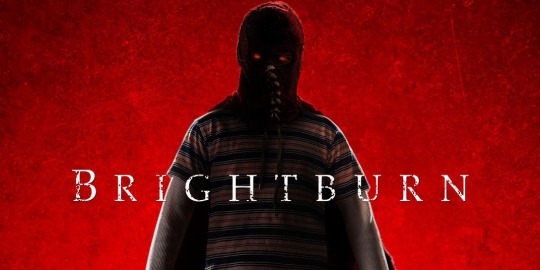
One of the biggest complaints that people have against Superman is that he's overpowered. I'm no comicbook expert but based on what I've heard from comicbook analysts, the fact that he is overpowered can be an issue with bad writers; however, the best stories turn that "flaw" into a feature, by focusing on the conflict others face by having to confront the a perfect, powerful hero. So, with such an all-powerful good guy, it practically begs the question... What if Superman was evil? For legal reasons, this Sony movie can't just outright admit that their main character is based on Superman™ (since the movie rights still belong to Warner Brothers despite how much they've been abusing it), so instead of “Clark Kent”, Brandon Breyer is a child with an alliterative name who is completely invulnerable to harm, possesses astonishing strength, develops the ability to fly as fast as a speeding bullet and can fire lasers from his eyes. This guy is Superman in all but name and, of course, personality, since he turns out to not exactly be a "good guy". And, rather than being from Smallville, this kid's alien pod crash-landed in Brightburn, Kansas - hence the title. See, this isn't just an evil superman, but an evil Superman origin story...
And to be honest, and that's the first mistake. Don't get me wrong, piecemeal revelations regarding this kid's powers are cool, but this movie doesn't really dwell on that. Instead, we're given one or two creepy scenes where the kid learns about his powers (and his origins not long after). But, he basically learns his abilities through the course of a single day, and can use them with great skill and accuracy from then on out. The only reason I can think of as to why they fast-forward through these is because the writer didn’t know how to make an immortal, unstoppable child scary unless he had all of superman’s powers, so they wrote him to have his full loadout from the offset.
Sure, the way those scenes are shot are very effective, and the music swells appropriately - but you probably already knew that since they were all in the trailer. In fact, everything original in this movie shows up in the trailer - the first few "kills", the creepy outfit, his interaction with fellow kids and even some of the scenes from the third act (although, in the movie the gore isn't censored). To be frank, this whole movie feels like it was shot for the trailer. Each scene feels like it was designed to be cut up and edited into a cool scene for the trailer, to advertise the "evil superman" gimmick. So, despite the fact that this has good cinematography and editing, it feels like it was wasted.
Part of the reason why it feels that way is because there aren't really any characters in this movie, they don’t act like normal people, but rather they need to act in a contrived way to take us from one horror set-piece to another. So, there's not so much character growth and development, as instead there are a series of character actions, to keep the plot going. The kid dresses up in a creepy cape and hood for no explained reason - and at one point he actually flies away in the middle of a scene just so that he can make a costume change and return wearing the creepy hood. The mother keeps secrets, for no explained reason, only to reveal them at the most dramatic moment. The kid goes from an all-powerful tyrannical psycho back to pretending to be a regular boy as easily as the flick of a lightswitch, whenever the plot requires it. The local police somehow intuits that the most likely killer in the town is an eleven year old child, simply because of a tag at the crime scene which looks like his initials, despite the fact that they have no reason to believe that this kid is capable of the such superhuman acts. The kid himself also decides to draw detailed sketches of all of his crimes, for no explicable reason other than so that someone can find it later in the movie. And worst of all, there are some really effective scenes in this movie which I thought were interesting, but each time those subplots were quickly dropped.
One subplot was based around Caitlyn, a local schoolgirl played wonderfully by Emmie Hunter that the superpowered kid seems to find cute, but when he discovers his powers he starts to stalk, abuse and harass her. In each scene she acts the hell out of it, making you feel terrified for her, since she looks so scared and vulnerable, but there’s a total of two, maybe two-and-a-half scenes where this happens, only to then move on to more horror set-pieces. There are also a few scenes where Mr Breyer, the father played with convincing fear and anger by David Denman starts to suspect that his “son” is even more alien than he first thought, but this whole subplot seems to occupy a little over five minutes of screentime. I also want to praise the work of Duncan A. Dunn, who portrays Brandon Breyer the main “evil superhero” character, because although he sometimes seems kinda dull, I know that this isn't bad kid acting. In the earliest scenes we get to see him emote, and when he resorts to intimidation in one scene, he is scary even without the mask on, so I know for a fact that this this kid can act very well, which means it has to be the direction making him to act so unnaturally.
See, the absolute worst part of this movie is that this kid isn't a real character. Sure, he is an “evil superman”, but the thing is, the kid never chooses to be evil, there’s not actually a character-driven reason behind it. What makes him evil is that a creepy voice from his birth-pod tells him to be evil. In fact, by the way that he’s forced to repeat the alien words, and even slowly understands what they mean, it seems to be implying that it’s compelling him to be evil. Sure, there is a scene or two where he acts uncaring, and he outright says that he's superior to other people, but there's no reason to believe that he chose to believe that, or was raised to have these evil feelings. Instead, he might as well have got an "evil" software update when he synced with his birth-pod...
You might be thinking that I'm being a spoilsport - that it's not about the story but the horror and death scenes. Well maybe, but they're not done very well either. Okay, that's not fair, they are done as well as any other horror these days... there is pretty convincing blood and gore, and they take advantage of that R-rating. The kid’s victims experience very explicit trauma and it’s not discreet - it’s often framed centre-screen for us to see in explicit detail. Although one or two scenes made me question the director’s understanding of biology, it wasn’t blatant enough to detract from the effect they were going for, so if you’re squeamish, this is not the film for you. This is your standard gory R-rated Horror. And that’s my problem here - they don’t really seem to do anything interesting with the evil superman concept. Sure, he wears a spooky mask, but other than that, there’s nothing that gives this monster any personality. For instance, Brandon (for reasons that aren't really explained) seems to makes electronics malfunction and lights flicker when he's angry; but the only reason for this is so that they can play into the spooky flickering lights trope. He also has the ability to move at superhuman speed which he uses effectively - in one scene (which, again, we saw in the trailer); but the main reason for this power is either so that they can justify the offscreen teleportation trope, or simply to make him pop up in a few dozen jump-scares, like every other teleporting ghost or demon in horror films since the early 2000s. The kid also has laser vision, which he does use for just one interesting scene; but, the main reason he has it seems to be so that they can make his eyes glow red against his dark silhouette when he's chasing people in the scary scenes.
The part that annoys me the most is that he keeps playing hide-and-seek with his victims (often using superspeed) during the scary scenes, and will even slip away before he's caught, which doesn't make any sense. To me the scariest part about an evil superman would be that he's invincible - he’s literally an unstoppable monster - but even if you don't agree, you can't deny that this kid has no reason to run away, since literally nothing can hurt him. Rather than playing peekaboo, he could simply stalk them like Terminator, or maybe even like the succubus from It Follows, and just tear through anything that tries to stop them. This might make sense if he was doing these things in secret, but the story seems to go out of its way to debunk that theory, since it is both heavily implied and explicitly stated that he sees human beings as inferior and worthless, so why does he keep lying to appease “inferior” human beings? It’s not even like there appears to be some conflict within him about whether he should be evil or not because as I mentioned there’s no character growth, he’s just suddenly evil because alien technology told him to be.
Now, if they did some of this stuff to pay homage to the horror tropes that inspired this, but also did something new and original as well to really take advantage of the fact that they have an evil superman on their hands, then I would be rejoicing instead of ranting, but they don't do that. You could easily rewrite this so that the kid is possessed by a demon, or being haunted by a killer ghost, and the movie could be identical. I think you'd only have to rewrite the end, and that's just because they saved one of their iconic "evil superman" moments for the end, but it’s not enough to give this film a personality of its own - this kid may be superman in all but name, but this film is just a generic, modern horror movie in all but marketing.
So, at the end of the day (and the film) the best part of this movie appears to have been the pitch: What if Superman was evil? Yeah, it's a great question, but so far we haven't gotten a very good answer. The best that this movie can come up with is "well, if he was evil, then he'd probably kill a bunch of people" ... yeah that's true, but whilst they're not wrong, I don't think that's the same thing as being right.
Death, Bloodlust and the Hollywood Way... 6.0 ⁄₁₀
#A Viewer's Review#Brightburn#superhero#horror#evil superman#elizabeth banks#david denman#duncan a dunn#emmie hunter#R rated#gore#death#off-brand superhero#sony#definitely not DC#kelnius
13 notes
·
View notes
Text
Film Allusions in Crimson Peak
Hi, all! So because I am deep in my horror movie feels at present and, as horror is a genre that some of you are new to/unfamiliar with, want you all to have some more context for Crimson Peak as an intertextual Gothic pastiche, I thought make a little list of films (mostly horror) that CP references, alludes to, or visually echoes (other than Jane Eyre or any iteration of “Bluebeard,” that is). This list is certainly not exhaustive, but I hope will give you a starting place at understanding the scale of the intertextual web this movie is weaving (also maybe give you some movie recs if you’re into horror/classic cinema. I’ll try to include links to films in the public domain).

Nosferatu (1922) and other early 20th century cinema
Del Toro makes use of a lot of the aesthetics and techniques of film from the late Victorian period/early 20th century (appropriate since Crimson Peak is set in the 1890s - incidentally one of the peaks of Gothic literature). One of these is iris shots/iris transitions (shown above in this screenshot from Nosferatu). Iris transitions are when a circular black mask over the shot shrinks, closing the picture to a black screen (very common in early horror film and 1920s cartoons, ie Betty Boop). If you’d like some very iconic, silent vampire cinema, you can watch Nosferatu here at archive.org for free.
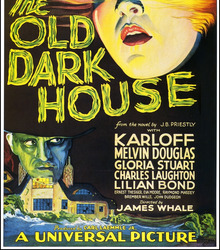
The Old Dark House (1932) | Watch free on Archive.org
Seeking shelter from a storm, five travelers are in for a bizarre and terrifying night when they stumble upon the Femm family estate.
A trope codifier for the haunted house movie, complete with oodles of Gothic weirdness, including those ooky spooky, co-dependent Femm siblings.
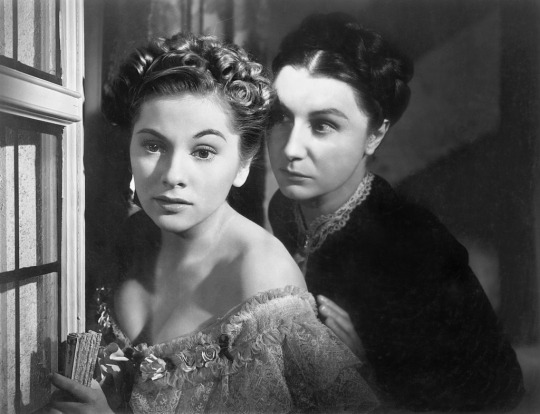
Rebecca (1940) | Watch free on Archive.org
A self-conscious bride is tormented by the memory of her husband's dead first wife.
Based on Daphne Du Maurier’s novel of the same name (itself heavily based on Jane Eyre), this Gothic variation on “Bluebeard” was Alfred Hitchcock’s first American film, won two Academy Awards, and is still considered one of the best psychological thrillers of all time. Features an overbearing female figure who directly interferes with our protagonist’s marriage to her, er, Prince Charming in the form of a Sapphic housekeeper obsessed with keeping the memory of the first Mrs. De Winter alive.

Notorious (1946) | Watch free on Youtube
A woman is asked to spy on a group of Nazi friends in South America. How far will she have to go to ingratiate herself with them?
Don’t drink the tea! Also, butterfly-backed chairs. Allll the butterfly-backed chairs.
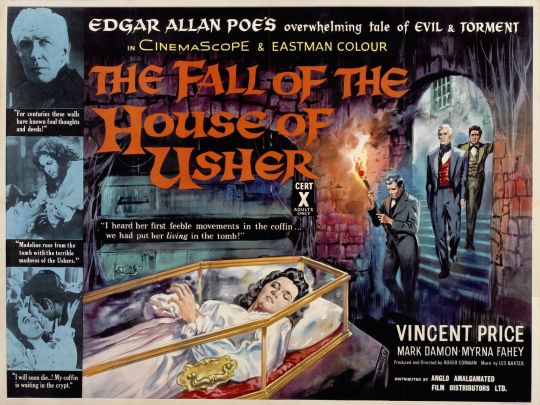
The Fall of the House of Usher (1960)
Upon entering his fiancée's family mansion, a man discovers a savage family curse and fears that his future brother-in-law has entombed his bride-to-be prematurely.
Two prongs here: Crimson Peak is very much playing with Edgar Allan Poe’s short story (incest siblings! Gothic manors sinking into the earth!) and evoking a particular aesthetic associated with a number of 1960s/70s “schlock” Gothic horror films like those made by Roger Corman who applied his use of vivid color and psychedelic surrealism to a number of Poe’s works.
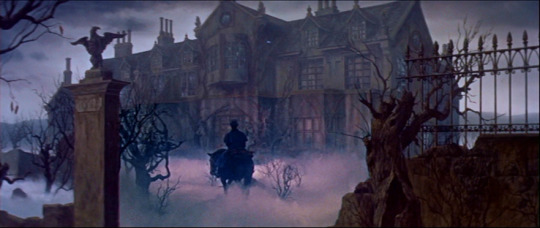
AESTHETIC!!!!! Speaking of aesthetic excess...
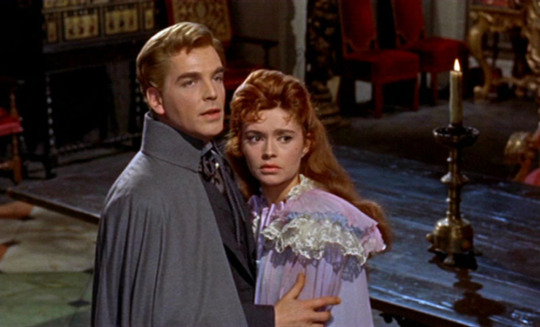
The Brides of Dracula (1960) and other Hammer Horror films
Vampire hunter Van Helsing returns to Transylvania to destroy handsome bloodsucker Baron Meinster, who has designs on beautiful young schoolteacher Marianne.
Known for a series of Gothic horror films made during the 1950s - 1970s featuring well-known characters like Count Dracula, Baron Frankenstein, and The Mummy, Hammer film productions hooked audiences with its use of vivid color, gore, sexy damsels in nightgowns, sexy women with fangs, sexy mummy girls, sexy... you get the idea. It left an indelible aesthetic mark on horror cinema since (including Crimson Peak). Also famous for catapulting the careers of Christopher Lee and Peter Cushing or, as you might know them, Count Dooku and Grand Admiral Tarkin from Star Wars.
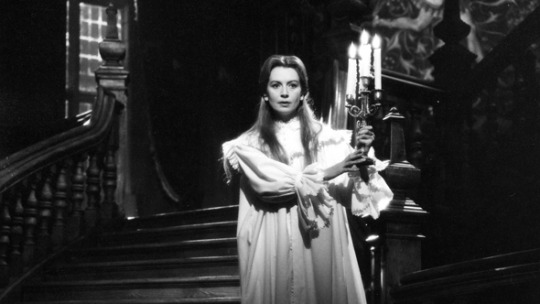
The Innocents (1961)
A young governess for two children becomes convinced that the house and grounds are haunted.
Frequently listed as one of the best horror films of all time, The Innocents (one of Del Toro’s direct inspirations -- clock the nightgown in the screencap) is a loose adaptation of Henry James’ seminal Gothic novella The Turn of the Screw.
So many more under the cut...

The Leopard (1963)
The Prince of Salina, a noble aristocrat of impeccable integrity, tries to preserve his family and class amid the tumultuous social upheavals of 1860's Sicily.
Another of Del Toro’s direct intertexts, which influenced Crimson Peak’s party scenes.
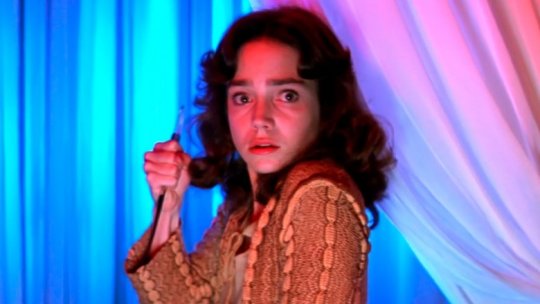
Suspiria (1977), the films of Mario Bava, and giallo cinema
An American newcomer to a prestigious German ballet academy comes to realize that the school is a front for something sinister amid a series of grisly murders.
A cult horror classic, Italian director Dario Argento’s Suspiria plays fast and loose with Gothic horror and fairy tale tropes, making for a slasher film quite unlike any other. Notable for its dreamlike surrealism, use of highly-stylized colorization, and sheer amounts of gore, Suspiria remains one of the most aesthetically influential horror films of all time and, looking at screenshots, you can maybe see its visual influence on films like Crimson Peak:
Guillermo Del Toro has also cited Mario Bava, another of the key figures in the golden age of Italian horror, as inspiration for his use of color and set design in Crimson Peak.
From Bava’s Black Sabbath (1963):

From Blood and Black Lace (1964):

Bava’s film, Blood and Black Lace, belongs to the giallo genre, which refers (at least, in English-speaking countries) to (largely 1970s) Italian horror thrillers/slashers notorious for their combination of intense, stylized violence and eroticism. Very much a precursor to the American slasher film.

The Shining (1980)
A family heads to an isolated hotel for the winter where an evil spiritual presence influences the father into violence, while his psychic son sees horrific forebodings from both past and future.
As film that also loosely adapts “Bluebeard,” it’s perhaps unsurprising that there are so many allusions to Stanley Kubrick’s adaptation of Stephen King’s novel of the same name in Crimson Peak.
And, man, does it have it all! Snowed in, Gothic entrapment! Threats of domestic abuse! Secrets locked away in forbidden rooms! Ghosts! So many ghosts!

Ghosts in the bathtub!
Ludicrously enormous amounts of blood! Innocent waifs with the ability to commune with the dead! Intrepid third parties who heroically make an attempt to reach the isolated Gothic hellscape to help our damsel in distress only to get immediately merc’d! It’s all here, y’all.... except the incest, of course.
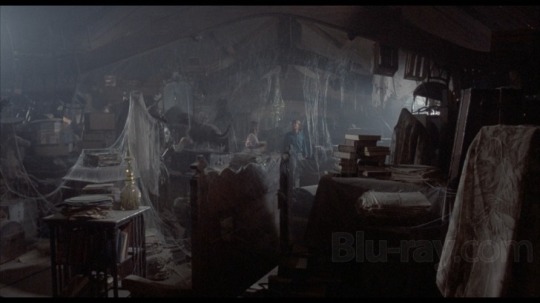
Flowers in the Attic (1987)
Children are hidden away in the attic by their conspiring mother and grandmother.
Ok, this is something of a cheat, as Crimson Peak is alluding more to V.C. Andrews’ infamous novel of the same name, not the 1987 film (which is an abysmally terribly adaptation and hilariously bad flick). Anyway, abused siblings are locked away in an attic... and... well... things get all... Sharpe family values, if you know what I mean.

Bram Stoker’s Dracula (1992)
The centuries old vampire Count Dracula comes to England to seduce his barrister Jonathan Harker's fiancée Mina Murray and inflict havoc in the foreign land.
If you liked Crimson Peak, I think you’ll enjoy this too, as, like CP, this movie is a sincere horror film, but also a pastiche/celebration of the Gothic and vampire cinema. It’s visually sumptuous and very high-energy (if you didn’t like CP or Moulin Rouge!, this one is probably not for you).
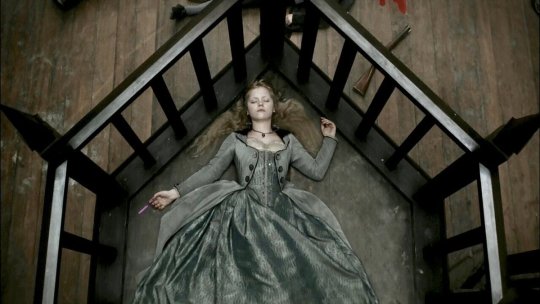
Sleepy Hollow (1999)
Ichabod Crane is sent to Sleepy Hollow to investigate the decapitations of three people, with the culprit being the legendary apparition, The Headless Horseman.
This is another one that, if you liked CP, you might enjoy. Based on Washington Irving’s "The Legend of Sleepy Hollow,” Tim Burton’s film evokes a number of genres and horror aesthetics, most notably the Gothic horror flicks of the 1950s/60s, to create a kind of Hammer Horror film for American Gothic.
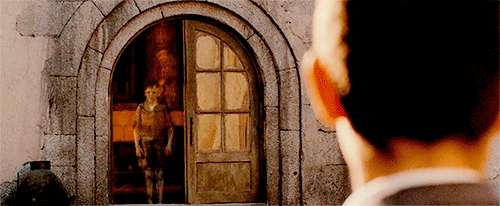
The Devil’s Backbone (2001) and Del Toro’s other films
After Carlos -- a 12-year-old whose father has died in the Spanish Civil War -- arrives at an ominous boys' orphanage, he discovers the school is haunted and has many dark secrets that he must uncover.
Crimson Peak is not Guillermo Del Toro’s first foray into Gothic horror, as ghost stories and dark fairy tales are very much his specialty (as we shall see again in Shape of Water later this semester). I highly recommend his ghosts-as-a-reflection-on-the-trauma-of-war film The Devil’s Backbone and his take on portal fantasy, Pan’s Labyrinth (2006), as they’re both excellent and you can see echoes between them and the effects/visuals of Crimson Peak.
31 notes
·
View notes
Text
You Can’t Go Home Again: An Analysis of Resident Evil VII
I'm comin' home, I've done my time Now I've got to know what is and isn't mine If you received my letter telling you I'd soon be free Then you'll know just what to do If you still want me

Introduction
Resident Evil VII is deceptive. Resident Evil, as a series, is deceptive. Numerous spinoffs and unnumbered entries turned the franchise into a tangled mess of intersecting characters, monsters, and conspiracies.
From the original trek through the Spencer mansion to the bombastic high-stakes setpiece-fest that is RE6, Resident Evil, after three console generations, had descended into itself, becoming bloated and seemingly incorrigible, impossible to nail down and define.
REVII was positioned as a return to form. Like the original Resident Evil, it is a straightforward story set in a spooky house, starring an inexperienced protagonist, Ethan, there with a simple but sympathetic and relatable mission: Rescue his girlfriend and get out. But REVII can’t help but dip into massive conspiracy as it navigates through what should be a relatively easy-to-digest story.
As Ethan searches for the missing Mia, who was away on a, get this, babysitting job, he encounters the deranged and inhuman Baker family, who have been granted a twisted immortality. There’s a pervasive black goo simply referred to as the Mold that seems to be infecting the family and their estate, spawning undead creatures and giving the Bakers supernatural powers. It’s not long before Ethan himself is infected, too.
The game then becomes a series of fetch-quests and races to various Macguffins as Ethan hurries to assemble a cure for himself, Mia, and their newfound ally, the Bakers’ daughter Zoe.
Resident Evil VII is a game running from its own past. As a linear narrative, it works fine, but it works better as a mood piece, a love letter to American horror films. It is meant to emulate a series of tropes and conventions. It's the product of two cultures—East and West— colliding head-on, and as a result it feels disjointed, dissonant, and yet wholly unique, fascinating, and, ultimately, compelling.
Resident Evil VII is an allegory for itself. It is a battle for the series’ soul.
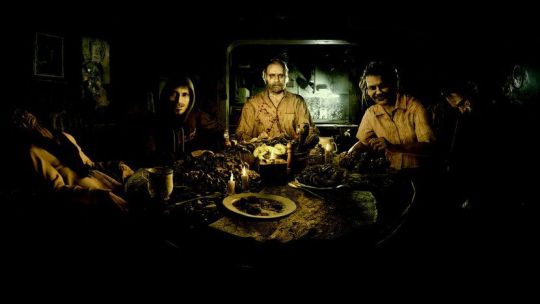
Aesthetics
Let’s get one thing out of the way first: Resident Evil 7 is not concerned with realism. It’s about simulating a horror movie; recreating their grit, visuals, and mood. In this way, it is a simulation of a simulation, and it leans heavily on the history and conventions of the American horror film without ever fully understanding them. You see this in direct, 1-for-1 tributes, such as the chainsaw fight with Jack that evokes Evil Dead 2, or the Saw-like machinations of Lucas Baker’s deathtraps, or the body found in the basement corner in the Derelict House Footage tape, positioned just like the victim in Blair Witch Project. And practically the entire front-half of Resident Evil 7 is pulled straight from The Texas Chainsaw Massacre.
This is par for the course for the Resident Evil series. The first game was a pretty standard take on haunted mansion horror, with some limited ventures into ‘80s action films, casting STARS as the badass special forces team in way over their heads a la Predator or even Aliens.
Resident Evil has always been about taking American horror and action tropes and sort of sifting them through Japanese culture. It is a imitation of American conventions, and it works precisely because it is so imperfect. Its dissonance happens to work perfectly for the mood of the genre. There’s something unsettling about how the details are just off; Louisiana looks like a still frame from an episode of True Detective, but it’s still evocative of how Americans perceive the swampland. Little mistakes regarding the area’s history and culture—the strange references to football, the inaccurate Civil War uniform—make things uncomfortable and strange. It’s like taking an English sentence, running it through Google translate into Japanese, and then translating it back into English again. Some general meanings are there and you may even be able to gleam some sense out of it, but it has lost all context and syntax and turned into something that isn’t quite English and isn’t quite Japanese—something that occupies the space between, something that has become a totally unique method of communication, with its own new signifiers and meaning. That’s Resident Evil. And that may explain a bit of the franchise’s ongoing identity crisis, too.
On a more surface-level reading, the aesthetics of REVII are vastly different from those of its predecessors, an approach to horror that’s a bit brighter but no less terrifying than previous entries. Remember, VII tells us, sunlight casts deeper shadows than darkness. This approach to horror is largely possible due to the wonderful lighting and particle effects at Capcom’s disposal, and though their tech struggles with faces, the uncanny valley works in their favor for this particular title, elevating that otherworldly feeling of imperfect simulation.
The Baker mansion and its surrounding area are dirty, grimy, grotesque. It’s southern gothic. The word “squalor” comes to mind. They choose to live in filth. Is there something ableist and maybe even contempful towards poverty about this dehumanizing of the Bakers? Maybe, but any sort of prejudice that the designers might be preying on here comes from a degree of separation, in that their only knowledge of that context, as mentioned before, is through American horror films, through simulacra. It is seperated by multiple layers, and so I find it hard to condemn their visions of the impoverished American South as anything but pulpy horror. Whatever the case, the true antagonists of the story betray any idea of prejudice against the lower class.
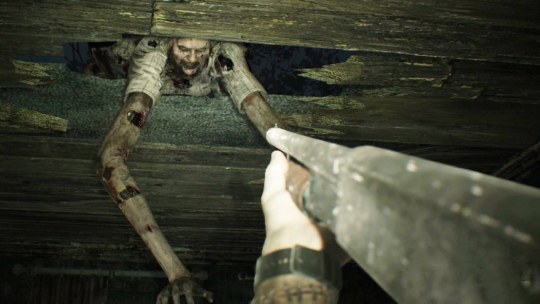
Perspective
Resident Evil 7’s protagonist is a camera. The series shifts to a first-person perspective for the first time, placing the player behind the eyes and within the mind of the game’s lead, Ethan. Despite this, the game has no qualms separating the avatar from the controller; there’s a sense that Ethan is his own character, with his own motivations not necessarily in line with the player’s.
I’ve heard the argument that what Ethan sees within the first half hour of the game would be enough to make anyone turn back. Why does he choose to go in alone? Why doesn’t he get help, or at least arm himself before he starts literally wading through corpses? No justifiable motivation could explain that.
Ethan is ostensibly motivated to look for his lost love, Mia. We’ll talk more about Mia later, but first I want to challenge the idea that this surface motivation is all that is propelling Ethan forward. Of course, you and I, and the developers, know that Ethan’s true motivation has nothing to do with Mia, and in fact nothing to do with Ethan himself, as he has no autonomy in the story. No, the motivating action propelling Resident Evil VII forward lies in the hands of the player. In a horror movie, the sort of films REVII is explicitly invoking, we can feel smarter than the protagonists. We know not to take a shower, we know not to look behind the curtain. In a horror game, we must specifically put ourselves in dangerous situations, and we do it because it’s fun. Without doing that, we can’t participate in the game. In REVII, since there is a degree of separation between player and avatar, our attention is specifically brought to Ethan’s flimsy-seeming motivation. In fact he moves forward because we push him forward, we keep him fighting. There’s a sadistic, manipulative relationship between Ethan and the player, but it’s also more complicated than that.
We sympathize with Ethan because of his love for Mia. Still, in some of Ethan’s barks and challenges to the Bakers, he expresses confusion, true ingenuity, sincerity, and a surprising and inspiring amount of courage and mettle. These motivations are enough for us to bind with Ethan, more so than in any other game in the series. Ethan is dumb, and we love him for that.
Mechanically speaking, first-person allows for some admittedly cheap but still fun jump scares, but it more importantly creates room for and necessitates an extreme amount of detail. Players can inspect drawers, cabinets, and cracks in the floorboards, unlike ever before. Monsters have a more threatening sense of scale, and so Resident Evil VII frequently plays with perspective and height, making its signature footsoldiers, the Molded, lumbering, giant masses of black knots, while also making its primary villain surprisingly pint-sized.
The first-person perspective also gives way to an effective new move, the block, crucial on the higher difficulties. The block gives Ethan a defensive verb and sort of grants the player a satisfying “cower” button. It doesn’t always make sense (how could an arm block a chainsaw?) but it paces out the game quite well against melee enemies, and it lends a visceral clutter to an already elegantly messy game screen.
Speaking of visceral—the new perspective’s greatest strength is probably the way it facilitates body horror. In RE7, you’ll have limbs chopped off, knives driven into your ribcage, and horrible masses of crawling grubs shoved down your throat. It’s a very personal, intimate horror, one that wants to gross you out while it makes your controller shudder and vibrate in resistance. It brings the player deeper into the shell of Ethan, and it creates a atmosphere of trapped, hopeless dread.
In a way, Resident Evil has been grasping at this perspective since its inception; think of the first encounter with a zombie in the first title, how the game shifts to Jill or Chris’s eyes, how the undead slowly turns to face you, its rotted mouth stuffed with human brain. This moment of body horror was essentially our introduction to Resident Evil’s mood. The perspective in Resident Evil VII, and our mouth being stuffed full of rotten flesh as we watch on, helplessly, brings the whole thing to a complete circle.

Kinetics
The movement in Resident Evil VII is deliberately slow, almost plodding. There’s a sense of weight to Ethan and his actions, necessitating such things as the aforementioned block button as well as a dedicated turn, a verb that is becoming more and more common in triple-A games, it seems. There is a sprint button, but there’s no real way to get Ethan to break out into an actual full-on run, ironic considering the urgency of the situation he’s in.
You could hand-wave away his plodding speed by saying it has something to do with his recent infection, but the Resident Evil series has always inhibited its protagonists in order to simulate the physical ramifications that fear has on the body. Despite arming the player to their proviberial teeth, early RE games aren’t about player empowerment; they still want to be a struggle to survive. So the series balances its arsenal of weapons by inhibiting the avatar’s movement. This is of course subverted in Resident Evil 4, further dismantled in 5, and completely out the window by the time 6 rolls around, but 7 is, again, intended as a return to form, and so we see a slower pace to all of Ethan’s movement. It makes up for the increased precision in aiming that the first person perspective allows.
REVII’s movement and control schemes are nowhere near as innovative and revolutionary as RE4’s over-the-shoulder controls or even RE1’s tank controls. But they still work remarkably well, and this is largely due to how the environments are designed to accommodate them. RE7 is filled with little nooks and crannies that demand careful consideration. Most of the time, they’re empty, but they are so discomforting they feel like intrusive negative space. A quick-turn button means that you always have a way to quickly glance over your shoulder. It creates a paralyzing set of blindspots to the player’s immediate left and immediate right.
Some of the guns in RE7 feel flimsy to fire, unsatisfying and cardboard-thin. The pistol has little weight or feedback, and despite the fact that the submachine gun is one of the most effective weapon in the game, it never really feels great to pull the trigger. It’s all just a bit too high-tech and light, and it clashes with the game’s mood. The shotgun, on the other hand, is incredibly satisfying, with a wonderful kick and a beautiful cascade of gore and blood to compliment each round. Meanwhile, swipes with the knife feel weak and desperate, appropriate as the knife will be little more than a box-breaker or last-ditch effort for the player.
I want to note how well the sound design compliments the movement in Resi 7. Each creek of the floorboard that comes with each step enhances the mood. Everything works harmoniously towards a feeling and an atmosphere, even if it isn’t, by the strictest definition, realistic. Remember, Resident Evil VII doesn’t strive for realism. It strives for a different sort of immersion, one that engulfs the player in familiar iconography rather than relatable and recognizable situations.
The puzzles in Resident Evil VII include the lock-key affairs that are synonymous with the series, though some of them work in interesting or subversive ways. Take the shadow puppet puzzles, that ask the player to rotate a certain key until it casts a shadow that fits into a mold or image. It’s clever to ask the player to think about the game’s lighting; it weaves together the environment and the objective. It draws attention to light and shadow, it takes time and manipulation. What it doesn’t quite take is the lateral thinking necessary for most of what you’d call puzzles. No, the puzzles in REVII are slave to the game’s pace, not its challenge. They give you tasks to do, things to fetch, and moments of quiet discomfort to break up the sometimes bombastic noise of gameplay.

Doors
Doors play a significant role in the Resident Evil series. In the first title, they masked loading screens and acted as gateways for player progression—a lot of that game’s pacing is defined by finding and using keys. In REmake, some doors will shake and slam as you walk past them, implying that enemies are waiting for you on the other side.
But doors are also important tools for survival; each door in Resident Evil is a barrier to keep enemies at bay, because each room is treated as its own discrete environment. Zombies (mostly) can’t get through doors. If you can’t deal with an enemy or enemies, you flee towards the door and use it to place a divide between you and them. Doors are powerful mechanically and thematically in Resident Evil and REmake.
In RE7, they work in a different way. You press a button to initially crack them open, but the game makes you physically push them open as a separate action. In this way you must commit actual movement to the action of entering a room to open a door. You need to make a serious mental and physical investment in order to progress.
This is nothing short of brilliant. You can’t back away from a room after opening the door and survey it for safety before plunging in. You have to go in headfirst, and this gives the game control over moment-to-moment player progression. The doors in Resident Evil VII area synecdoche for the game’s entire design; a mindfulness in mood, movement and control that services a feeling rather than a sense of realism or accuracy.
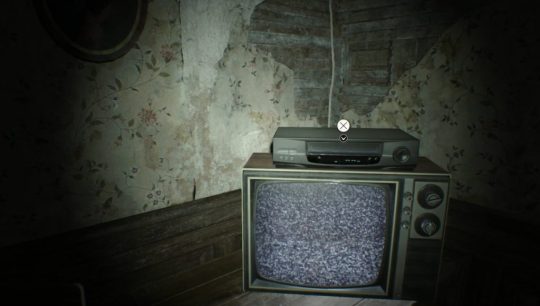
Videotapes
Resident Evil 7’s obsession with horror films extends beyond the game’s aesthetics and into its mechanics. It is fascinated with the concept of video tapes, beyond simply using these tapes as a way to evoke the mood of found footage horror. Rather, it finds a mechanical purpose for the tapes, turning them into puzzle pieces that help Ethan escape.
When we are first introduced to the videotape mechanic, it’s in the initial shack area, part of the demo that was released before the full game. The tape belongs to an unlucky film crew, working for some imaginary (but wholly believable) reality show about plumbing the depths of abandoned houses. In what is RE7’s most obvious expression of its main purpose—placing the player in a horror movie—the player takes control of the cameraman, and indeed the camera itself, and by proxy—through the method by which Ethan diegetically experiences this scene—the tape. We are the footage, and though it supposedly happened in the past, we are now controlling it in real time.
Disturbingly, the crew goes through almost exactly the same paces that Ethan went through just moments ago, and since we see how it ended up for them, it suggests that he is probably in a great deal of danger.
But the tape shows that there is a secret passage in the fireplace, one that the player could have totally missed without its aid. This establishes a pattern; the player will encounter three more tapes during their journey, and each one will convey a little more information and context to not only the player, but to their avatar, Ethan, as well. Not all of the tapes are mandatory for progression, but they are a wonderful way to present missing pieces of the puzzle to the player, through methods that are thematically appropriate and never wrestle control away from the protagonist. The tapes are essentially keys, but they are infinitely more interesting than a simple progression lock.
The most effective and interesting tape is perhaps the most well-hidden one. “Happy Birthday” is buried in a cupboard in the attic, and it is disturbing footage kept safe and secret by the Bakers’ son, Lucas.
The footage is of an elaborate deathtrap set up by Lucas, who’s positioned as a sort of genius psychopath as an in-universe explanation for some of the game’s puzzles. Lucas has captured one of the poor erstwhile documentarians, and the player takes on this victim’s perspective. Interestingly, all semblance of artifice—a camera recording the footage—drips away in favor of this perspective. Through the magic of movies, we become this character, one-step removed from our hero Ethan, yet still somehow viewing it through his eyes. If the intro tape had us jump back in time to where Ethan has been, this tape foreshadows where he will go.
Since we already know that the victim of the trap doesn’t survive, it’s not a failure to participate in Lucas’s machinations. Instead, it’s presented as the scripted, linear path that we must follow. The lethal puzzle culminates with a task that requires the victim to uncork a barrel of oil, leading to the explosion that ultimately kills the victim in the tape. But the action that springs this trap just yields a password. If one were to go into the trap with some prior knowledge of that password, one would be fine. And that’s exactly the position the tape leaves Ethan in. Since he, by way of the player and the tape, already knows the password, he’s able to escape Lucas’s trap unharmed.
This means the tape isn’t necessary for success. If the player somehow fails to find the tape, they just have to play the death trap twice. Once they continue the game and run through the puzzle a second time, they’ll realize they can just skip over the deathtrap, since they already know the password. It’s a puzzle that is proofed against stumping a stumbling player.
It also extends the horror movie motif pulsing at the heart of Resident Evil VII. It’s an attempt at creating something that the series has sometimes dabbled with, but never fully explored–the idea of elaborate, claustrophobic death traps. You’ll see spiked walls and bottomless pits in other Resi games, but never something quite so sinister and unique, not to mention devoid of enemies or threats beyond the traps themselves. It is a quiet, challenging horror, one that pits the player against themselves, and I think it’s more than strong enough to stand on its own as a full game.
The video tapes in Resident Evil VII stand hand-in-hand with the tape recorder save points and evoke a certain era of technology, a halted progress that crystallizes the Baker mansion at a moment in time, and suggests that they’ve paused their evolution. It also subtly reminds players of a time and a place, the same crucible of factors that led to the creation of the horror films that inspired Resident Evil VII. It’s a horror born out of grime and dust rather than shadows and moonlight.
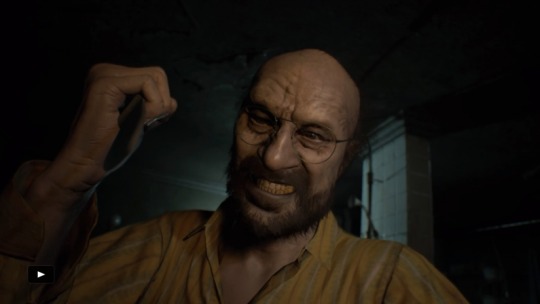
Jack
Jack is the first member of the family you encounter; you catch a glimpse of his form plodding through the woods, and he eventually kidnaps you and brings you to the centerpiece of REVII’s introduction, the family dinner, where he makes himself known as an intimidating and controlling presence.
After Jack’s pulled away by the arrival of a deputy, you escape from your binds and start to move through the mansion, but of course he quickly catches on to your plan. What follows is the most compelling, proof-of-concept sequence in all of RE7; a game of cat-and-mouse through a tightly wound series of narrow corridors, with the slow-moving but ultra-powerful Jack following you close behind.
The wing of the house that Jack chases you through is a well-thought out arena, with a few hidden escape hatches and multiple ways to double-back. It makes movement and navigation feel clever and fun, while still keeping a sense of looming dread. You’ll double-back multiple times, and you’ll always have the plan b of escaping back into the safe room on the opposite end of the hallway, as far from your objective as possible.
This scene is marked, most notably, by a few scripted scenarios designed to catch the player off-guard; one, Jack can burst through a wall and surprise the player, but only if both characters are positioned just right—some players will never even see this sequence.
It takes courage to develop entire sequences that some players will never see. It’s difficult and resource-intensive to design and place such moments in a game. But it pays off in REVII; these moments are some of the most memorable in the entire game, and you can tell a lot of care and time went into making Jack’s sequence pitch-perfect. It’s truly the highlight of the game and a Capcom more willing to take a huge gamble might have used it as the entire framework for the game. As it is, it’s the stand-out chapter in the game.
After a bit of exploration and a few confrontations, you’ll encounter the now most certainly undead Jack Baker, during an otherwise slow-paced hunt for a few statues. He catches you off-guard and the game challenges you to once again play cat-and-mouse. As a result, the entire Jack encounter sort of plays like a three-act structure in its own right; you encounter him once, run away, quiet exploration, encounter him again, more puzzles and exploration, and a final, bombastic, Evil-Dead-as-hell encounter in an enclosed space.
The fight challenges how well players have learned to navigate tight corners and small spaces while evading a slow-moving Jack. Perhaps it would have been more appropriate to present them with a cat-and-mouse challenge, one that added new wrinkles in order to act as a sort of final exam for the Jack chapter. But it’s hard to argue that this fight isn’t a trippy power fantasy for the player, and the way it flips the player’s relationship with Jack works.
Ethan has now escaped the mansion, but finds himself in the Baker grounds writ-large. The game doesn’t open up or become less linear, but it does explore some novel new locations. Unfortunately, that variance comes at the cost of some consistency. Before moving on to the next location, the player encounters a trailer belonging to Zoe, who ostensibly sets herself up as a mysterious ally. We first encountered Zoe through a phone call in the Baker house, where she warned us we were in grave danger. Zoe is not that interesting as a character, and mainly serves to complicate the game’s narrative, which starts out simply and becomes more and more complicated, to its weakness. Zoe is an element of that. She’s not well fleshed-out in the main game, and she’ll later be part of an arbitrary and superfluous player choice that feels tacked on. Here, however, she’ll play the role of mysterious sherpa for a while.
After a short break to resupply and catch their bearings, the player will soon enter the second house, the old house, and the domain of Mrs. Marguerite Baker.
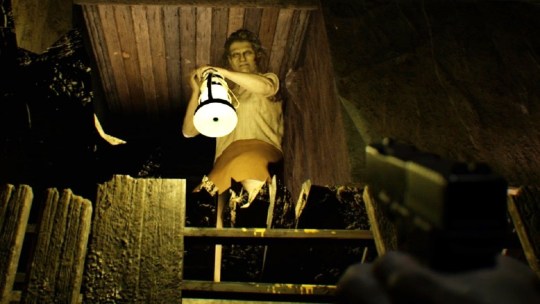
Marguerite
Pacing-wise, Marguerite’s domain is when RE7 really starts to slip in its footing. It’s not exactly bad gameplay, but it does sag a bit, and a few fetch-quests lead to the previously mentioned flamethrower and a pretty frightening if rhetorically uninteresting tape starring Mia.
Marguerite’s gimmick is insects, cockroach-like bugs that swarm Ethan, fly around the damp wooden shack, and build nests that the player must flush out using the burner. The bugs create some variance in the enemies that RE7 will throw at the player, but they aren’t terribly fun to fight. What’s more, the old house doesn’t feel quite as well-thought-out as the larger Baker Mansion, and though it also follows a somewhat circular layout, its hallways and doors are less distinct, and its rooms are less geometrically interesting.
Jack is horrifying because he feels threatening and powerful. Marguerite is horrifying because she’s unpleasant to see or hear. It’s a skin-deep horror that relies on physical reactions rather than mental ones. Marguerite is repulsive, not necessarily terrifying.
Perhaps most disappointingly, we don’t learn very much about Marguerite at all, before or after her infection. Jack gets a moment of redemption later in the game, and Lucas and Zoe are fleshed out in conversation and flavor text around the Baker estate. Marguerite, on the other hand, only gets bits and pieces of story—she’s really more about an image than a fleshed-out idea. The DLC supposedly characterizes her out a little better, and gives hints to what she was like pre-infection. There are glimpses here and there that suggest she had an affinity for religious iconography; she has a habit of creating small shrines to Eve’s “gift.” This was a potentially rich vein that Capcom could have explored in more detail to make Marguerite feel like more than just a wife and mother.
The highlight of Marguerite’s section, by far, is her boss encounter. Set in a small two-story greenhouse, the boss fight begins when she startles you by popping through a window and grabbing your legs. At this point, she has mutated into a Junji Ito-style horror, with long arms mimicking spider limbs.
Her boss arena is a work of art. While Jack’s pit is somewhat simplistic, Marguerite’s stage has a layout simple enough to grok but complicated enough to provide ambush points and blind spots. There are doors that are blocked from one side, but give the player a route to double-back. There are ceilings and walls and windows for Marguerite to crawl on and climb through. There’s ammo hidden in cabinets, but there’s a risk-reward of wasting burner ammo to open these cabinets—though the burner is the most effective weapon against the matriarch. And, echoing the gameplay in her larger domain, the boss fight is dampened by moments of quiet stalking, though here the line is blurred between cat and mouse; you’re fighting back, and if you can control the tempo of the fight you’re frequently on the offense.
There is some sexual imagery to Marguerite’s final transformation, as her weak point is a hive-womb, and she crawls around on all fours while stalking you. It’s RE taking a page out of Silent Hill’s book, and it might feel a little cheap and grotesque if it wasn’t executed with the grimy style of a western grindhouse horror flick. No, REVII has little reservations about what it is by this point; it fully accepts that it is campy gross-out horror, but never to the level of shtick. It still takes its scares seriously, and this level of sincerity lends it a lot of heart. It makes no apologies for being disgusting, and in that way it’s lovable, just like the shlock it’s based on.
After a grueling fight, Marguerite calcifies and crumbles to dust, leaving behind a lantern for Ethan, who is free to move on to the next chapter of the game.
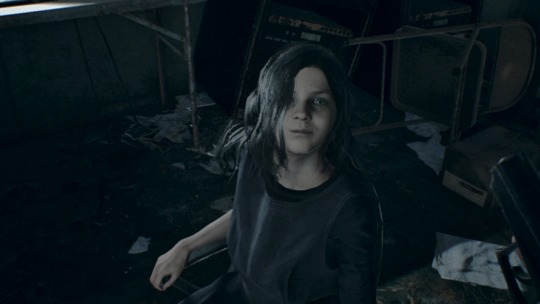
Eveline (Part 1)
But before Ethan moves on, he makes a detour to the attic and the kid’s bedroom.. Demonic children are nothing new, horror-wise, but REVII sows the seeds of its main antagonist achingly slowly, placing her quite literally right under the player’s nose while still breadcrumbing morbid story details to keep the hook. It’s not a deep story, or even all that unpredictable, but it is compelling enough to push Ethan forward.
You’ll notice I’m not paying much mind to the grand details of the plot, and that’s precisely because the story is secondary to a mood. This is why so many of its characters are so tropey. They don’t need to be real people, they need to serve a purpose.
If this is all sounding a bit harsh, let me assure you; I fully believe anything other than REVII’s broad strokes narrative would probably feel a little too fiddly and intrusive to serve what the game is trying to be. There’s just enough dressings of a compelling story to keep players interested in what’s going on, and that’s exactly the way it should be.
The Baker’s son, Lucas, plans to make you work hard to reach his lair, and as a result there’s a quick and gruesome return to the main mansion to fetch a key out of a corpse and battle some extra molded. This largely feels like filler and fluff, but it goes a long way to building Lucas up as a bit different from his parents. He’s more sinister, more cunning, more self-aware and human. You’ll also encounter Grandma a few more times, placed within the critical path, always watching and always silent.
RE has always been noteworthy for its clockwork puzzles, and the series has frequently lampshaded these puzzles in cute if unbelievable and ultimately unnecessary ways. The police station in RE2, for example, was supposedly a decommissioned art museum, as if that makes any sense.
In REVII, though, it’s the machinations of a character, the inventive, sociopathic Lucas, who, as it turns out, is a major antagonistic force behind the game’s entire plot. His reveal as the true antagonist of the game is brought on with little fanfare. It’s mostly revealed in DLC and notes. But it’s similar to Wesker’s heel-turn in RE1. It doesn’t purporte him to be the main villain of the game, but it sets him up as a possible series-wide antagonist.
Your mileage may vary out of this twist. Some might like having a face to the horror, and the stories of Lucas as a child, spying on his sister and setting traps for neighborhood bullies, are chilling in a lasting way. But the game doesn’t do a great job of selling Lucas as a planner, and the whole thing feels a bit contrived in the face of REVII’s greater narrative.
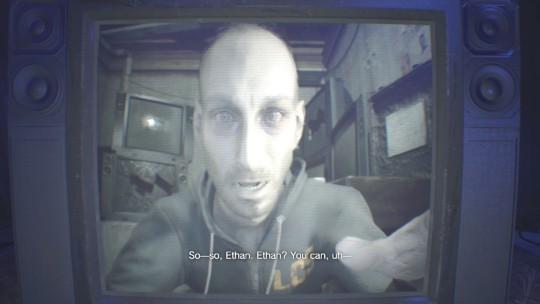
Lucas
In the Videotape section, I discussed the happy birthday tape and how it uses the conventions and structure of a video game to set up REVII’s most interesting puzzle. I briefly glossed over how the tape and Lucas as a character invokes the found footage aesthetic so important to Resident Evil VII’s style, but in the Happy Birthday puzzle—and through the rest of Lucas’s death traps—we see another piece of horror movie inspiration come to life; the complicated, convoluted deathtraps of films like Saw and Cube.
This sort of claustrophobic psycho-horror came about out of budget constraints. The first Saw was hugely influential because it allowed for an inexpensive yet wholly effective reworking of the slasher flick. It was successful commercially, and it was appealing to producers because it had the built-in simplicity of a few simple sets and some inexpensive practical effects. It was a streamlined reworking of the genre for the 21st century.
If Jack stands in for the ‘70s-era slash-fests like Texas Chainsaw, and Marguerite is a melding of ‘80s and ‘90s body horror from the West and the East, then it’s temporally appropriate that Lucas is the representative for 21st century gore flicks. In a way, REVII is a tour of the genre’s modern history, an exploration of its tropes as they evolved. It’s a love letter to three eras of horror.
Mechanically, Lucas challenges the player to stop, move slowly and deliberately, and fully assess the environment. There are tripwire bombs and spike traps littering the hallways of his home, and though you will still fight standard molded, they’re sort of a trivial threat by this point. No, Lucas demands that you think about the game’s environment as hostile and unforgiving. This is something of a change when compared to the circular, narrow hallways in the Baker Mansion and the Old house, where the game’s architecture and hidden pathways were one of your only weapons against your pursers. Here, Lucas isn’t following you, but he’s attempting to anticipate your movement. You’re not being chased, you’re being funneled.
Lucas leads you into the Baker barn, which he’s set up like a gladiatorial arena. If you needed any further evidence that the game is now fully banking on Saw homages, the hanging pig-corpses should be proof enough. This environment is incredibly quiet at first, but its architecture betrays its true nature; the intersecting, stacked hallways are layed out too perfectly for it to not be some sort of combat arena. In most games, this discord can be laughable; in Resi VII, it builds tension and suspense, and therefore works a little better than it might in, say, a pure action game or a shooter.
Depending on your difficulty, you’ll face some number of a new type of enemy, the fat Molded. These are bulky, powerful enemies who spew bile, one of the few projectile attacks in the game. Overall, they’re more intimidating than actually threatening. By this point, you’re armed to the teeth, and the barn’s layout gives you plenty of ways to obscure line of sight and take cover. But this boss encounter most vitally introduces the fat molded into the ranks of foes you’ll encounter. Resident Evil has a history of introducing powerful minions with such fanfare; they bring around a new, tough enemy type, build them up as an intimidating, powerful force, and then later seed them into the ranks once the player is more capable. It’s a way of ramping up combat challenges and creating an interesting endgame.
Next up is the happy birthday puzzle. Once you beat Lucas’s escape room, he gets angry and tosses a bomb into the room, which you can use to blast the wall and escape. By the time you make it to his control room, Lucas has already fled. There’s a short trek to the boathouse, and a fully-loaded safe room is a pretty good indicator that a big fight is about to go down. There’s a sense of finality to the proceedings, considering that you’ve now worked your way through the main Baker family. Still, there’s something like a quarter of the game left, and it’s when most people say REVII really goes off the rails. The pace and mood of the game is about to undergo a major shift. But first, it’s the final battle with Jack.
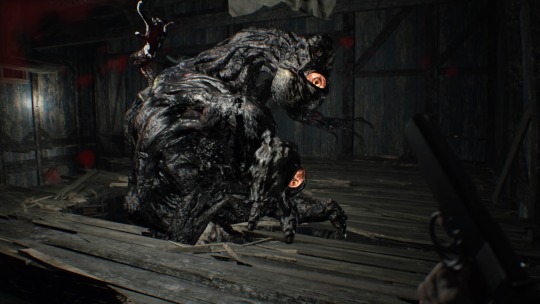
Jack’s Return
Ethan’s final encounter in the Baker residence brings his time with the family full-circle. Jack has come back from the dead yet again, and he’s mutated beyond any recognition. This is the beginning of REVII’s slide fully into the conventions of the series, away from the new-age slasher flick pastiche and into the gamey, japanese bio-horror that defines the series.
The fight with Jack is a fairly standard boss battle that asks you to shoot the glowy parts when they start getting glowy. There’s a smart sense of player-enemy placement and blocking and a clever use of levels that keep the fight from feeling dull.
The barn burns over the course of the fight, and eventually it’s all but completely destroyed. Once the fight wraps up, Jack will grab you as a final deathrattle, and you’ll be forced to inject him with one of the two cures you’ve cooked up. This means you only have enough serum to cure one other person, and the game is going to make you choose—do you fulfill your promise to Zoe, or do you stay loyal to your original mission, and rescue Mia? It’s a dull, binary, choice that simply determines the ending of the game, as well as what amounts to an optional boss fight. It’s set up to either reward or punish the player, rather than challenging their conceptions of the game’s world and Ethan’s place in it. Put simply, there’s a right answer and a wrong answer, which makes it fundamentally uninteresting.
Whoever the player chooses, the pair will then make their escape down the river.

Mia and the Tanker
The boat crashes, and REVII plays its final third-act twist; a shift in perspective, moving the action behind the eyes of Mia, who is all-too-familiar with the washed-up tanker. The twist is that Mia is much more than she seemed and was hiding a few secrets from Ethan. She’s a mercenary, hired to escort a bioweapon on a commercial tanker in a covert operation. That weapon is Eveline, the main antagonist and the driving force behind the sentient Molded force that both corrupted the Bakers and created the monsters the player has battled this entire game.
This twist is nothing short of baffling. It is unexpected, but it is not a subversion of any player expectations; it’s a twist that devalues the previous rising action rather than usurping it, and it inflates the scale of the game’s conflict beyond ‘creepy house’ and into ‘international high-stakes bioterrorism.’ It’s disingenuous and exhausting, as Ethan is now relegated to a bit player in a bigger conspiracy.
All that being said—it’s Resident Evil sinking back into its traditional mold. Wesker’s heel-turn and the Umbrella conspiracy elevated the first game’s spooky mansion into a secret megascience lab. That twist set the pace for the series as a whole; a convoluted narrative rooted in a distinctly Japanese anxiety over superweapons.
Here’s the thing; I don’t think the twist is all bad, actually. I think there’s something charming about how RE feels it is so vital to create a wide, entangling conspiracy to tell such a tight and quick narrative. It’s an impulse that the series truly cannot escape, for whatever reason. It is never content to tell a story about horror on a small-scale. It needs to dip into some kind of worldwide threat in order to tie all its narrative strings together. Would REVII be stronger without the tanker chapters and the larger ramifications of its effect on the narrative? Probably. Would it really be Resident Evil without such a grand mega-conspiracy at its heart? I’m not so sure.
It’s a complicated issue, because it begs the question; how much can you mess with a series’ DNA before you have an entirely new product? Is a mood enough to connect a series, or does there need to be an underlying thread that connects all the titles to its past? Is there simply too much baggage attached to such a massive beast of a franchise for it to ever escape its own legacy?
Ostensibly, the theme of Resident Evil VII is family. It’s the driving force that causes Eveline to throw off her controllers and drive the game’s plot forward. It’s the bond that causes Ethan to go after Mia, and it's the question that Zoe struggles with as she turns against her mutated clan.
Conversely, then, it is appropriate that Resident Evil VII struggles against its predecessors and the legacy they have created. Like Zoe, it is fighting for its own identity while still maintaining a certain loyalty to its origins.
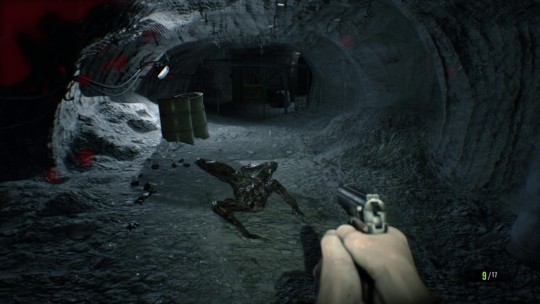
Eveline (Part 2)
The last location in the game is the salt mines, which act as a sort of final combat dungeon, overrun with Molded. Unlike the tanker, however, the salt mines afford the player a ton of firepower and ammunition. It’s all about player empowerment now, as the scales have been tipped in Ethan’s favor. Fighting the molded is now trivial.
The mine is also set up as a sort of ground zero for the Molded. There are secret labs and documents filled with research on the molded dotting offshoots and chambers.
There’s a thrilling race up a spiraling column and a few more fights with the fat Molded between Ethan and Eveline. She’s in the guest house, and this final confrontation acts as more of a cathartic emotional highpoint than a final gameplay challenge. The mines were the real final test, and though there are some small challenges to the encounter with Eveline, it’s more in position to wrap up REVII’s mood and story.
The player is now up against Eveline’s psychic powers, and it’s about as hokey as it sounds. However, the audiovisual presentation is strong enough to suck the player in, and it still feels emotionally resonant and threatening, even when dipping into the absurd.
After the player figures out how to guard against Eve’s blasts, they reach her decaying body. Like Lisa trevor in REmake, Eve is positioned as a victim of larger, sinister forces, a capitalist war machine that took a little girl and turned her into a weapon. This sympathy for the devil ultimately induces genuine pity for Eveline, and it, again, shifts the focus of the story onto a more worldwide conspiracy and less on its play actors.
Eve’s final form is massive and grotesque, but most poignantly, it is part of the house itself. The Baker estate has been Ethan’s sometimes-ally, sometimes-enemy, and it’s only appropriate that it takes a leading role for the final moments of REVII. The final set piece is one of a massive scale, and it brings attention to the sky above, where dawn is beginning to break through what has been a seemingly endless night. Evenline mutilates Ethan one more time as choppers begin to fly in overhead, and finally, a deus ex machina in the form of a massive handcannon lands next to Ethan’s head. He fires a few rounds and Eve crumbles to dust with a final deathknell.
Ethan is rescued by a man introducing himself as Redfield and working for the series’ signature villians, the Umbrella corporation, and REVII, despite itself, insists on teasing its place in the series’ overarching, complicated mythology. A brief epilogue showcases some more lovely, True detective-esque air shots of Louisiana over narration from an exhausted Ethan, before fading to credits.
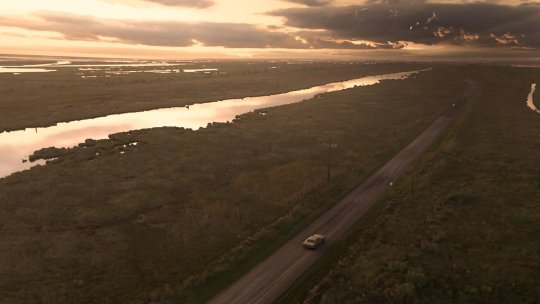
Resident Evil 7 is a revisioning of the series that coined the term survival horror. It’s an invocation of a mood and aesthetic, brought into interactivity. It is a product of its technology and time, as such a detailed and intimate horror wasn’t possible even in the last console generation.
At the same time, it’s also a troubling return to form. Resident Evil can’t seem to escape the baggage of its prequels or the conventions of massive conspiracy that provides the framework for its otherwise small-scale horror. It is an antithesis to itself, as it attempts to invoke personal intimate horror through large-scale conflicts between massive capitalistic and militaristic conglomerates. A Resident Evil game will inevitably go off the rails at some point, but its mood and method determines if the player will be along for the ride. RE4 went from moody creepout to action-packed campfest, and it never missed a step. REVII stumbles a bit more, but it promises a strong return to what made RE great, especially after a few strange forays into action in RE5 and 6.
Yet REVII didn’t enjoy the commercial success of those two titles, though it did see a fair bit more critical acclaim. It’s a bold move to shift a tentpole franchise as dramatically as capcom did between RE6 and REVII, but the game is clearly a love letter to its inspirations. REVII is a celebration of Western conventions seen through a Japanese lens, It is a product of dissonance, and that’s what makes it so compelling.
Despite its flaws, Resident Evil VII is one of the best horror games of the latest generation. It provides genuine moments of horror and a piercing, inescapable atmosphere of tension and horror. It is cathartic and wild, moody and visionary, and awe-inspiring in its execution.
Maybe the next entry will lean further into the horror aspect of survival horror, and will have the courage to shake off a messy legacy of legions of the undead.
#resident evil#resident evil vii#criticism#games writing#games criticism#capcom#horror#horror games#survival horror
4 notes
·
View notes
Text
Myu Reads
I am making a list of books/series that I read and enjoyed over the past few years, especially since I began listening to audio books regularly. I am making this list not in order of favorite to least but In The Order of Fluff to Grimdark.
The Wind in the Willows.
Charming characters, each with unique personalities, a classic, well-written series of short stories that has lessons for all ages to learn.
The Wizard of Oz.
Experience the magic of Oz. Much of which was removed in the classic movie adaptation. It wasn’t a dream after all.
Anne of Green Gables.
The tale of a spunky orphan girl being taken in by an middle-aged brother and sister duo.
A family dynamic that is not seen in modern westernized settings any longer.
Slice of Life. Light reading. The first book is the best book.
Howl’s Moving Castle.
Howl is a roguish wizard out to have fun and games manipulating the world around him. Sophie just wants to make hats and live a simple life, but is forced by a curse into adventure and into the path of Howl.
The movie and book are only alike on the surface. There is more charm in the books and Howl actually has a backstory.
Mrs. Frisby and the rats of NIMH
A tale of a mom wanting to save her children, told on top of the story of humanity corrupting nature and abusing animals.
A true “strong female protag” without the need of the female being either cruel, cold, or emotionally distant.
A Wizard of Earthsea
The movie Tales from Earthsea used the character’s names only and lifted elements from all the books rather than just adapting the first one.
Honestly I remember more from the sequel books more than I do the first one.
The Chronicles of Prydan (The Book of Three, The Black Cauldron)
A hero’s tale of a simple boy, an assistant pig keeper, wanting to become something greater and finding out that being a hero it isn’t all glory and fame.
Characters and Lands based off of old Welsh mythologies, the same ones that also inspired the Welsh folk heroes that later became King Arthur’s Court.
The Once and Future King
The Sword in the Stone half of the book would have made it closer to the top of the list. But the second half involved some rather graphic deaths and fights (a gory depiction of killing a unicorn among them).
Edgar Rice Burroughs John Carter of Mars (Barsoom) and Tarzan
Both characters helped define what would later become the modern super hero genera.
John Carter was a direct inspiration to Super Man and the Tharks popularized the idea of little “green men” of Mars. (The entire population of Barsoom are very color-coordinated, tbh. Green, Red, Black, White, Yellow). Many ideas created in this series are prolific in Science Fiction of today.
Tarzan of the Apes can be read by itself, no need to get into the later books. The original character is so popular that any attempt to stray too far from the core characterization leads into disaster. The movie “Greystoke” is perhaps still the best adaptation of the character to screen, and it was a deconstruction of the character.
Redwall
It is easy to get away with whole-sale death when it is done with animals, however many of the animals act human-like and that needs to be taken in consideration
Baby’s first “Dark Fantasy”. Dialog is written plainly for younger audiences, but subject matter is straight out of adult fantasy (mass murder, kidnapping, slavery, war of attrition).
Harry Potter
If you just watched the movies you are missing out on a lot of the descriptions and world-building in the books, especially in the second half of the series: Goblet of Fire, Order of the Phoenix, Half-Blood Prince, and Deathly Hollows.
The second half is when the series went from older-child reading to young adult as the characters went from child to teenagers in the books themselves.
Ready Player One, Armada
An easy introduction to retro 80′s and 90′s pop culture, old computer games, and science fiction dystopia.
If you are a layman, a young adult, or didn’t pay attention to most of the media during that era the books do gloss over and explain most of the references made.... sometimes too often.
Armada is not as well seeped in pop culture as RPO, but it is a much more streamlined story and you can get a clearer judge on the author’s actual writing capabilities without the kick-back of nostalgia.
The Hitchhiker’s Guide to the Galaxy
There are just somethings that can’t translate well from text to screen.
One of those series that is best when read in High school or if you are a fan of British Humor.
The Scarlet Pimpernel
A masked hero come to save French Aristocrats and Nobility from the guillotine of the Revolutionist Government. Among one of the first novels to set down the common tropes for heroes with secret identities to come.
History and backstory might be a bit too heavy for younger audiences to understand.
The Complete Sherlock Holmes Collection
There are two great audio book versions of this: one by Simon Vance, the other by Stephen Fry. Vance is a long time audio book professional and also narrated the Dune books and in general just having him read the book is a good indicator that it would be done well. Fry is a famous comedian and colorful character actor and was in the recent Holmes movies as Mycroft Holmes.
Barns n Noble has a beautiful leather-bound hardback edition of the Complete Collection as well for $25, if you are the type of person that reads the book and listens to the audio at the same time. The book will look nice on your shelf afterwards.
Victorian/Edwardian Horror-Romance: Frankenstein, Dracula, Phantom of the Opera
Classic stories, adapted and retold many times, it is always nice to get a perspective on the original works if you are only familiar with their newer incarnations.
Miss Peregrine’s Home for Peculiar Children
Darker than the movie.
A reminder that all N*zis are bad.
Children characters get killed just as often as adult characters
Deals heavily with mental issues and adults/authority figures gaslighting children.
Neil Gaiman’s The Ocean at the End of the Lane, Stardust
A couple “lighter” examples of Gaiman’s work.
Stardust is classic fantasy with a bittersweet ending.
Ocean is told mostly through the POV of an adult remembering his “magical” neighbors as a kid and his traumatic experiences with his parents and babysitter.
The Lost Fleet Series
What the modern space battle genera should be.
The battles are in real-time, using real physics. It may take hours or even days to find out if that heavy ballistics missile is going to hit its target or if the target moved out the way.
The characters are typical for the genera, but are still engaging. Though the love-triangle rears its ugly head.
NPC’s (Spells, Swords, and Stealth Series)
A new game is hitting select markets. One that has consequences not only for the characters in the game, but the players. NPCs inside the game find themselves thrust into the role of adventurers when a PC party drops dead in their small town.
Classic “role reversal” or unconventional class/char combos (Gnome Paladin? Half-Orc Wizard? Noble Lady Barbarian? City Guard Rogue?) It’s kind of the norm now days after the whole “Drizz’t the Ranger Dark Elf” became so popular in the 90′s.
Star Wars: Heir to the Empire (Trilogy)
The first official trilogy of the Star Wars Expanded Universe, now known as the Legacy series.
It is always interesting to read through some of the EU to see what the Cinematic Universe is “borrowing” from.
Grand Admiral Thawn was such a popular character that he survived being rebooted.
2001: A Space Odyssey
If you have no idea what was going on in the movie. The book will help.
H. P. Lovecraft’s Collection of Horror
There are lots of copy cats, but only one original H. P. Lovecraft.
Mild in terms of today’s standards, but still thought provoking.
Good you are still wanting something creepy/spooky with out it being full of gore, swearing, or other ‘adult’ content, or looking for nothing exceedingly long
A “next step up” after reading Dracula, Frankenstein, and other fiction of that era (penny dreadful, or horror romances).
Heinlein’s Lazarus Long Universe (basically, most of his books)
It is decent until the last 5 books when things really get duct-taped together, then you’ll want to pull your hair out
Time Enough For Love, Number of the Beast, Cat that Walks through Walls, and To Set Sail Beyond the Sunset are some of the worst offenders.
An Incest warning is needed.
The ideas of these stories are timeless, the writing not so much. Characters are antiquated and firmly in the “men’s club” of old-school science fiction. (Even the “strong female protag” in some of the stories still find time to be a wife and mother above all else. Many of the relationships are “open relationships,” so frequent wife/girlfriend swapping)
Starship Troopers
If you ignore the rest of Heinlein’s work, make an exception to at least read this one
Warns of the dangers of being in a global totalitarian society.
POC main character. Juan “Johnny” Rico. Something that was unheard of at the time of publishing.
The Silo Series (Wool/Rust)
Post-Apocalypse science fiction.
Not as dark as say something like bleak The Road or the bloody Red Rising, a PG-13 book.
Set firmly in the middle-ground of fiction despite the setting, the characters aren’t one-note, a solid little series of books and short stories
With some editing it could have been an other dystopia YA series.
The Great Book of Amber (The Amber and Chaos Chronicles)
High fantasy written with a modern voice. A Shakespeare and Arthurian setting. Avalon, Oberon, The “fairy realm,” Civil War. Court intrigue, back stabbing, fratricide. Unicorns.
Written in the 70′s and 80′s. Likely inspiration for other series like ASOIAF, Dresden, and The Witcher. Suggest reading this one before either of them.
The two main POV characters are enjoyable with a snarky sense of humor. The side characters have personality as well.
Multi-dimensional universe, one of the better ones.
Has a Table Top Game.
Welcome to Nigh Vale: A Novel.
Quarkie, Mysterious, and odd.
Heavily inspired by H. P. Lovecraft, X-files, and other conspiracy theory genera, but treated in a mundane manner which makes it unnerving in itself.
Do Androids Dream of Electric Sheep? (AKA: Blade Runner)
The book that inspired Blade Runner. To the point that many further publications of the book often call itself Blade Runner instead of its actual name (including the audio version).
The book and moves are only alike in theme, and some plot points
The book is bleaker, more Fallout than Ghost In the Shell.
Dune, Dune Messiah, Children of Dune, God Emperor of Dune
The “Lord of the Rings” of Science Fiction.
What started out as a “deconstruction” of campy science fiction like John Carter and Flash Gorden, and a “take that” to Issac Asimov and Heinlein’s style of writing shaped all science fiction written afterwards.
GRRM (A Song of Ice and Fire) is often compared to Herbert... for good and bad reasons.
Neuromancer.
The book that brought us the first REAL Cyberpunk in the 80′s.
It is interesting to see the ways they thought computers would be part of 21st century society back in the Cold War Era.
Mort(e)
Animals take over the world killing most of mankind along with it.
A mysterious “virus” sweeps through the animal population, and the Ants in charge began culling the animals to remove it.
The Hunger Games Trilogy.
There is a lot less HAM in the books than in the movies.
Upper Young Adult. Class Warfare. Post Apocalyptic Dystopia. Children killing children.
You can get into Katness’s head a lot easier, understand her reasons for being emotionally distant with people.
Jurassic Park, The Lost World
Dinosaurs and Assholes. Perfect Michael Crichton books.
The second one should be read just for the fact that the movie is nothing like it. The first movie had a passable resemblance, with some character tweaks... the second movie barely resembles the book at all.
The second attempt of Crichton writing a series about “high-tech theme parks gone wrong” (the first being Westworld)
Android’s Dream (John Scalzi)
When you find out why the book is called “Android’s Dream”... feel free to be grossed out.
Let’s just say the book isn’t about androids...
The Illuminatus Trilogy
Written in the 70′s. Plenty of Sex, Drugs, and Rock-and-Roll.
Some of the conspiracy theories will throw you for a loop, then suddenly you’ll remember that this is a comedy/parody book and gods are real.
fnord.
Cryptonomicon
A long fictional account about the invention of computers. Told against the backdrop of WWII and the Early 2000′s internet boon.
I feel this one is on par with the Illumanatus Trilogy when it comes to tone and feel, but with no magic-chaos-cults involved.
Parodies of Historical figures, large a corporation with their fingers in many-o-pot, main characters that would be considered counter-cultured for their time period finding themselves in over-the-top situations.
Neil Gaiman’s American Gods
Personally I found the book to be slow and meandering, but interesting as a whole.
Basically defines what people think Gaiman’s style is. Dark imagery, weird shit happening, and lots of contemplating your navel.
The Comoran Strike Detective Novels.
What J. K. Rowling is doing whenever she isn’t milking the corpse of Harry Potter.
Would be a better series in general without the fake love triangle...
The Godfather
The movie is better than the book, but then the movie is like in the top-5 best movies of ALL TIME.
The movie does follow the book for the most part, with some variation for time and content.
The Guns of August (Non-Fiction, WWI novel)
Accounts what caused WWI and the events of the first two months of the war.
It doesn’t demonize the Germans, Russians, or any of the sides in particular. It explains quite clearly as to what all their motivations were getting into this war and how the war ended up becoming a complete slog.
Realm of The Elderlings Series (Robin Hobb)
If you ever want to experience “the feelz” in book form.
The relationship between FitzChivalry and the Fool is one of the most anguished you’ll ever read about.
There is a lot of ship baiting however, as the Fool is genderfluid and Fitz refuses to believe their relationship is anything other than close-brotherly love...
About 60% of the entire series is seen through FitzChivalry “head as thick as a brick” Farseer ‘s POV, be prepared for lots of PTSD.
The Mists of Avalon
The classic tale of King Arthur imagined and told through the eyes of the women of the court.
There are no real villains in the series, even the most morally dark among them have justifiable reasons for what they are doing. Unlike something like Once and Future King. Mordred, Morgause and Morgan are not evil stereotypes, they have human real-world reasons for what they do.
The Red Rising Trilogy
The Adult Fiction version of The Hunger Games.... In SPACE.
Color-coded for your convenience.
All the surrounding characters are more interesting than the main character.
Your favorite character is likely going to die.
Darrow always reminding you about his fridged wife... even after he finds a replacement goldfish.
The Cycle of Arawn, The Cycle of Galand
In a world of black magic and white magic, it isn’t always clear on which side is good or evil.
Plot holes you can drive a truck through, or at least hope will get resolved/remembered in later installments.
Most of the charm of this series is the relationship between Dante and Blaze. The way they both converse with each other and the people around them is very reminiscent of Buffy Speak.
The Dresden Files (Harry Dresden... Wizard)
Dresden has a great mix of humor and cynicism.
Plenty of action, not entirely predictable in plot, and a heaping helping of stopping the forces of evil from destroying all existence.
A modern-era fantasy with plenty of demons, fairies, vampires, and ghost. Never loses the feel that it is set in the modern times.
Stephen King’s Horror-Fiction (The Stand, Under The Dome, IT, The Shining/Doctor Sleep)
The human condition at its worse told in speculative horror fiction.
The Forgotten Warrior Series (Son of the Black Sword)
Future Earth, brought back to an age of magic (or science-like magic) when demons fell from the sky and ravaged the planet. An entire race, the last survivors of the people that turned away the demons and drove them to the sea, are forced to live as slaves, vagabonds, and in perpetual poverty.
The Witcher Novels
Books are published OUT OF ORDER in America. Please read The Last Wish and Sword of Destiny short-story collections before the Saga books.
CDPR Games are a Fan-created sequel to the books, so the games spoil the books (especially the third game).
Netflix is making a (new*) show adaption of the novels with the author’s approval and getting advice from the game makers as well.
*we don’t talk about the old show.....
The First Law Trilogy
It will get worse. When ever you think things can’t get any worse. It always does. And you watch the characters struggle all the way through it and everybody around them dying along the way.
Don’t get too attached to anybody without a POV.
A Song Of Ice and Fire
The modern “Gold Standard” for Dark Fantasy when Game of Thrones brought it to the mainstream.
Just about everything black and grim can, has, and will happen.
Nothing is glorified, everything is awful. When something problematic to our modern society happens within the narrative, it is often treated with the weight that these issues are a problem and part of their corrupt society (things like incest, child murder, rape, abuse....)
Hannibal Lector Series (Red Dragon, Silence of the Lambs, Hannibal)
humanizes the most horrible of mankind.
if you had at least watched any of the movies and/or the show, read the books as well.
Dogsland Trilogy (J. M. McDermott)
Nothing good will come out of this. There is no hope for any of the characters. It starts out black and will end just as black. It is like a slice of life for the dirt poor and shunned. Forever on the run from hunters and discriminated against just because of being born. It ends where it began.
The Road
A story about a father and son at the end of humanity. There is nothing that can be done, a harsh struggle to delay the inevitable death of man kind.
2 notes
·
View notes
Text
October Book Reviews
Sold by Patricia McCormick ⭐⭐⭐
Amazing YA novel that reminded me of high school literature class.
Horrorstor by Grady Hendrix ⭐⭐⭐
I wanted to read something ‘scary’ for Halloween month, and what’s more terrifying than working retail? This book was funny and entertaining and the narrative worked really well, even if the plot was a bit predictable and borrowed heavily from horror movie tropes. Worth a read if you’d get a laugh at the thought of ikea furniture turned into torture devices.
Packing for Mars: The Curious Science of Life in the Void by Mary Roach ⭐⭐⭐
Last year, I read another book by Roach Stiff: The Curious Lives of Human Cadavers and enjoyed that as well. This book was similar in its unflinching curiosity, sometimes gross details, and smart writing. Mary’s descriptions of her research trips to NASA were very entertaining and I learned more than I care to know about the daily realities of astronauts and life in space.
Radical Acceptance: Embracing Your Life With the Heart of a Buddha by Tara Brach (A) ⭐⭐
I listened to this book while driving and so I wasn’t able to pay full attention to it but I still thought it was long. I understood that in order to process pain we have to let it in and then release it the first time she said so, and the rest was a little too repetitive. I did not really connect with the struggles of her patients and idk this book just wasn’t for me.
Bleaker House: Chasing my Novel to the End of the World by Nell Stevens ⭐
I wanted to like this book because of its cover (a penguin) and premise (aspiring author exiles herself to an island in the middle of nowhere to write her Book) but ... it just didn’t do it for me. I found Nell’s writing boring and the structure of the book kind of jarring - it went from present day (descriptions of bad weather, not packing enough food, to long stretches of non-writing), to excerpts of her novel, to stories about her past, and then back to the novel. I just found myself not caring anymore around the halfway point.
Tracks: A Woman’s Solo Trek Across 1700 Miles of Australian Outback by Robyn Davidson ⭐
My mom recommended this to me after seeing a documentary, digging up my dad’s old issue of Nat Geo from the 70s (she was the cover story), watching the movie starring Mia Wasowski, and getting excited about our upcoming vacation to Australia. She thought I’d love it - a strong, hippy, brave female protagonist of her own story - and I really didn’t. I didn’t like the writing style or the structure of the book (it started without any explanation of what might have contributed to Robyn’s decision to pursue this goal) and I didn’t find the journey especially interesting or inspiring. The read felt like a long trek through uninteresting terrain. Although brave, Robyn was also foolish. She was extremely ill prepared and this caused hardship for herself and her animals.
Lagom: Not Too Little, Not Too Much: The Swedish Art of Living a Balanced, Happy Life by Niki Brantmark (A) ⭐⭐⭐⭐
This book was one of my favourite reads for the month, and that’s a good thing too, because it was a stressful and busy time. Listening to it while driving helped calm me down and it was kind of like a form of meditation. I thought the book was just as its title promised: concise, pleasant, and just enough.
We Have Always Lived in the Castle by Shirley Jackson (A) ⭐⭐⭐
Another spooky book for Halloween month, this was a psychological, suspenseful, gothic horror which I quite enjoyed. Merrycat is a fascinating character and this book reminded me again of the ones you’d read in English class - there’s a lot to unpack there.
Soulful Simplicity by Courtney Carver (A) ⭐⭐⭐⭐
After spending years deeply in consumer debt, a diagnosis of Multiple Sclerosis inspired Courtney to make some significant lifestyle changes, which she shares in this memoir/guidebook. I really enjoyed it; because of her honesty and the way that she shared how being busy was harming herself and her relationships. She references Kondo’s The Life Changing Magic of Tidying Up and talks about her decision to pare down her wardrobe to 33 pieces of clothing. In doing so, she offered real, tangible tips for ways to live more with less. (side note: Wait, this was the book with the Project 333 challenge, right? Can you tell I’ve been thinking about decluttering/living more minimalist lately?)
Lovecraft Country by Matt Ruff ⭐⭐⭐⭐
My bro in law was reading this novel while we were all in Maui and just from his comments on the first chapter, I knew I had to add this book to my list. It did not disappoint. The stories were powerful, unnerving, and so well written.
Overall, I made an effort to read more books by women authors this month! The subject matter was of course all over the place, as were my ideas for NaNo, but despite some negative reviews, I thought it was a good month for reading! I was super busy and constantly driving from my work to my house to my coworkers house to the vet so it’s no wonder I got to read so much - I wasn’t spending the time writing/planning for NaNo (post coming soon)
0 notes